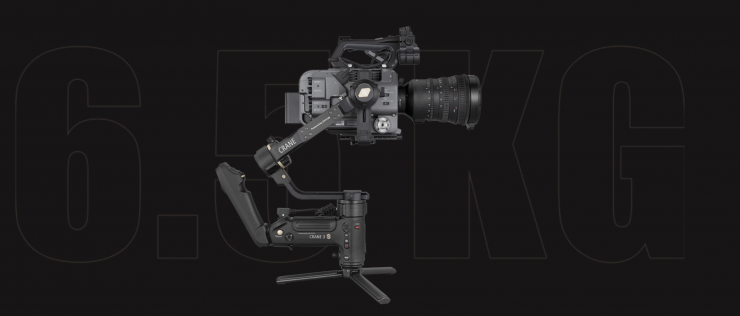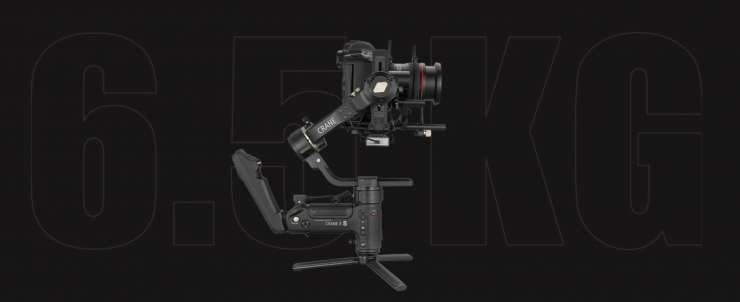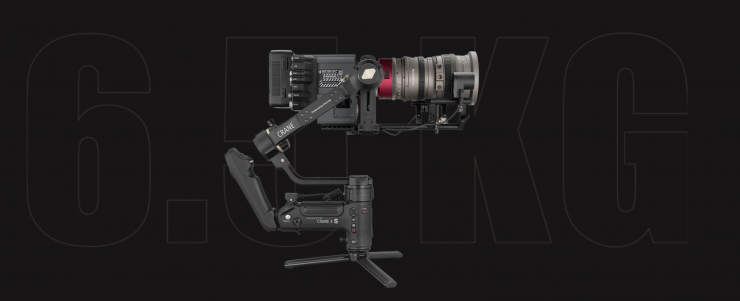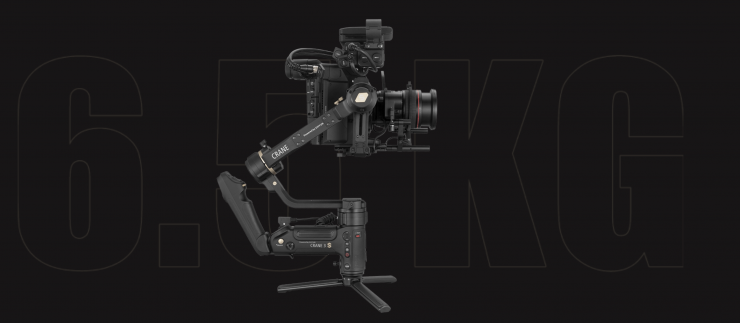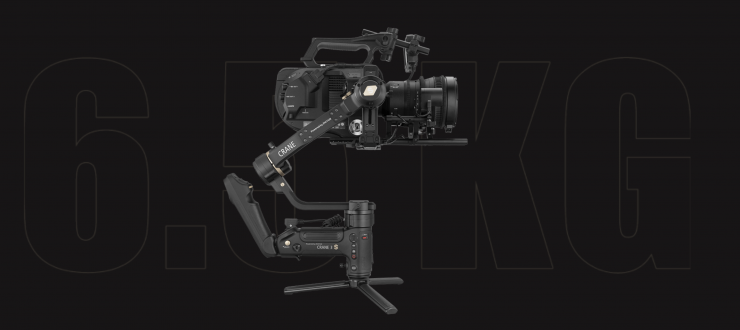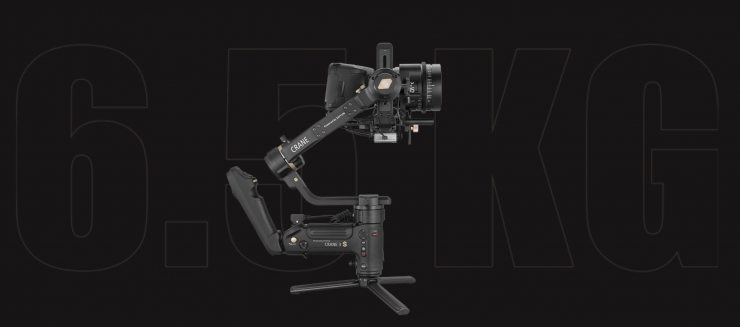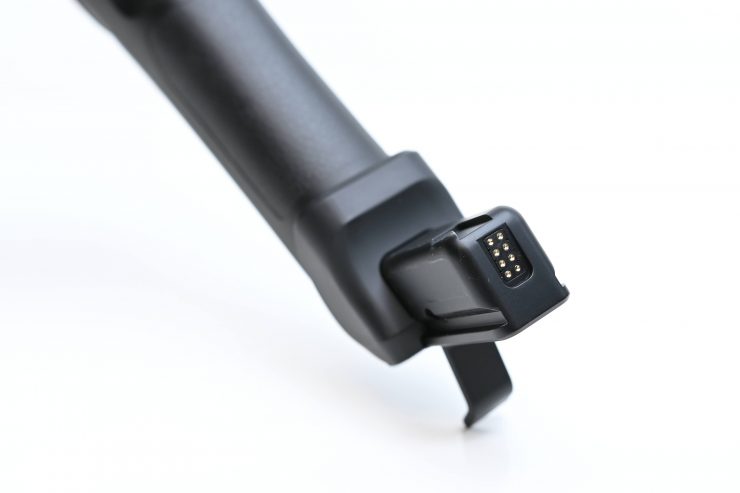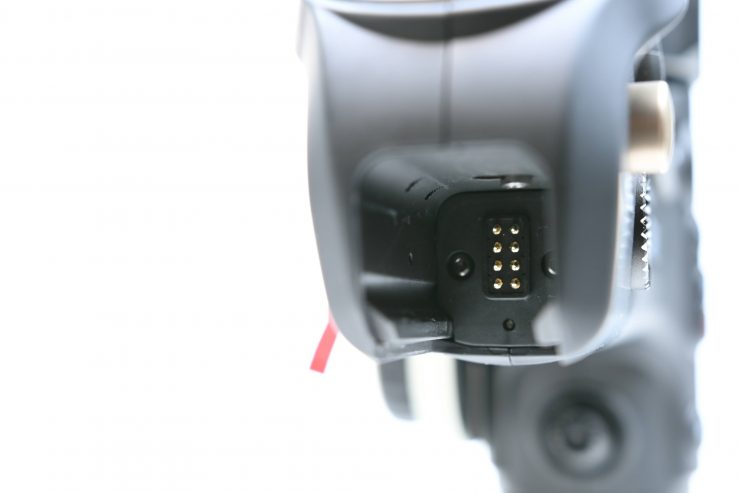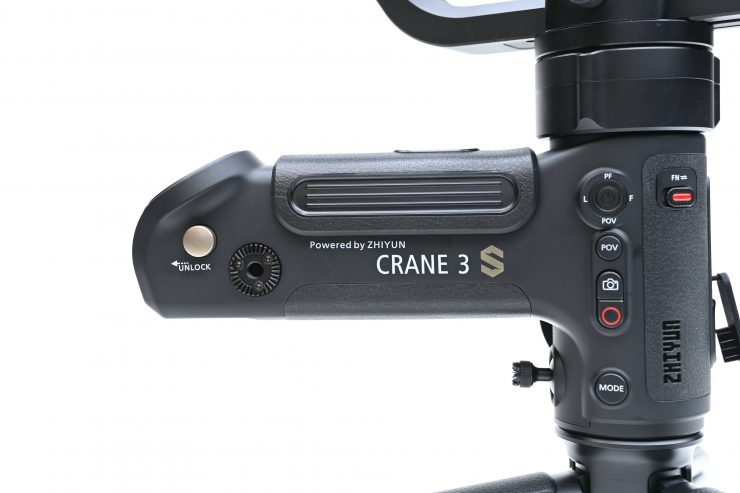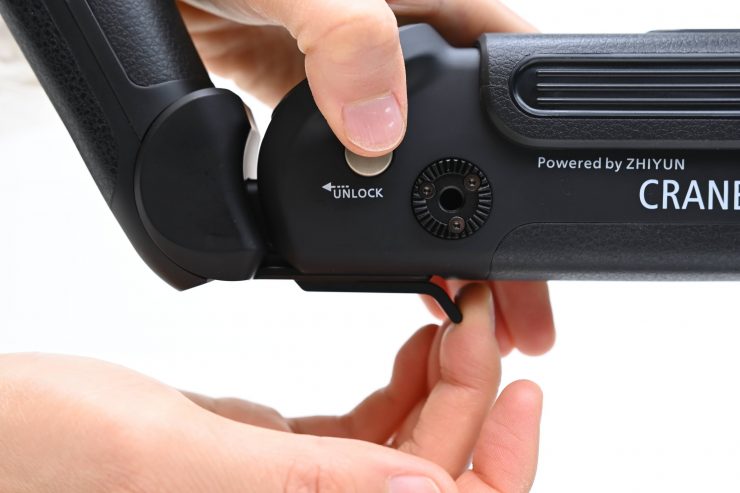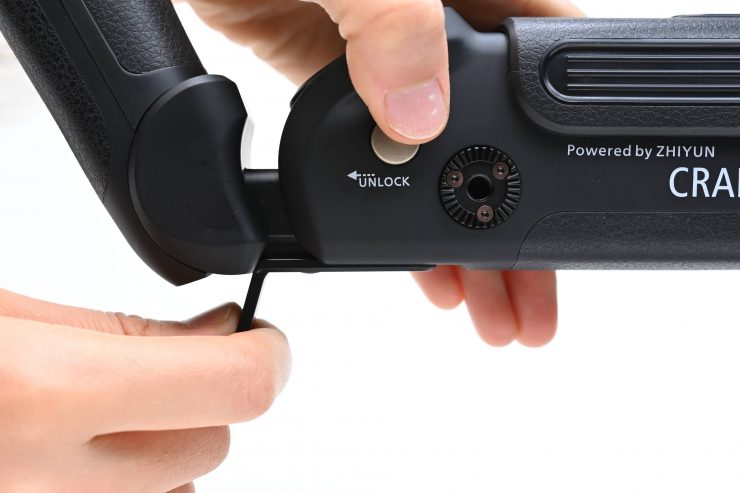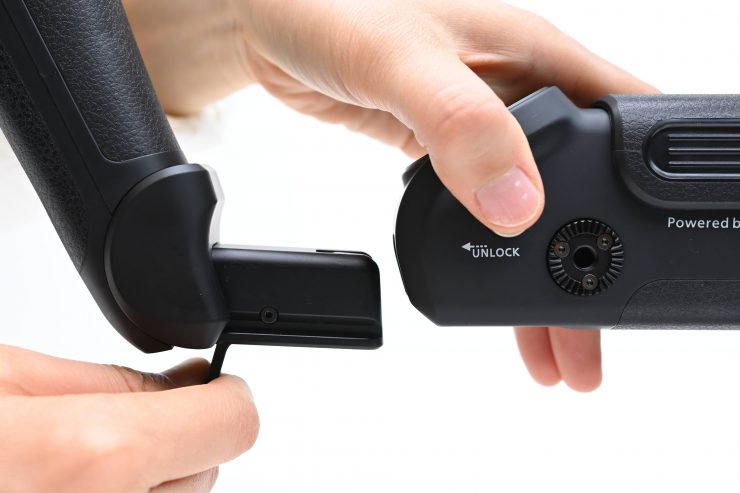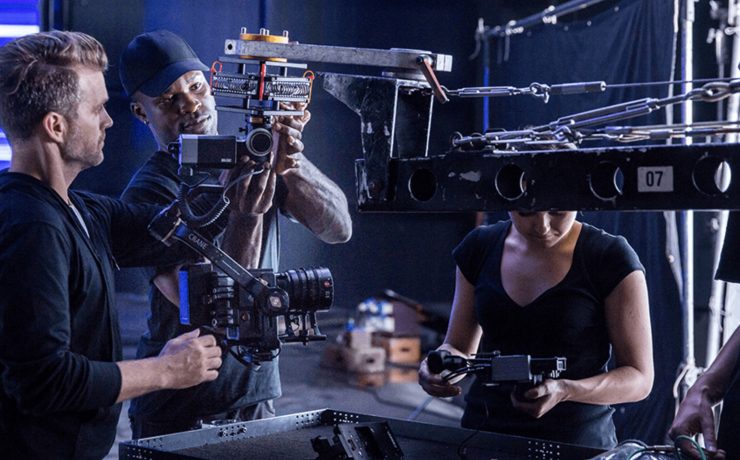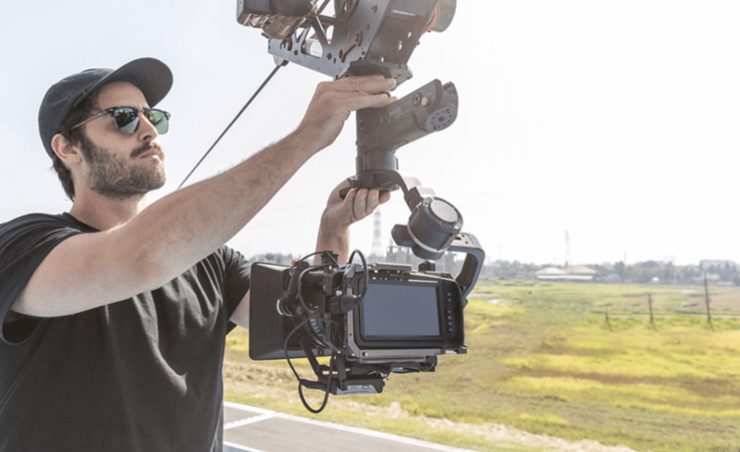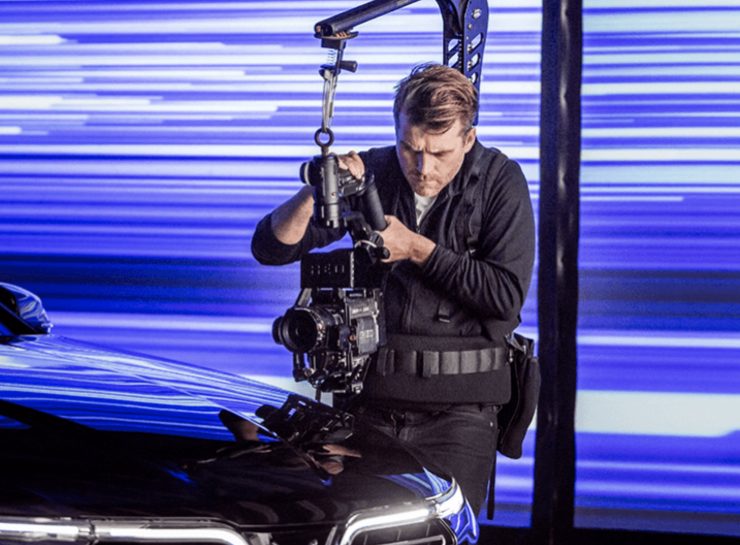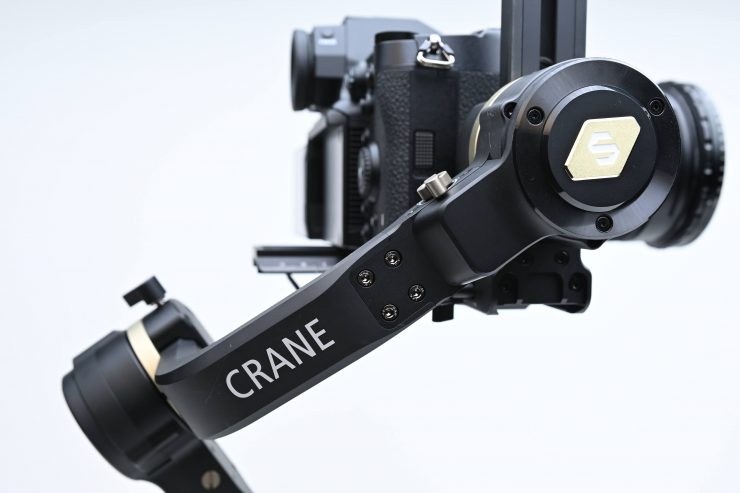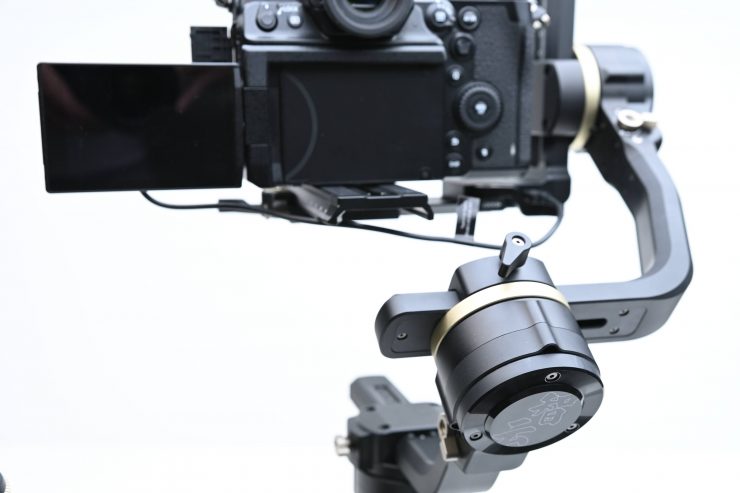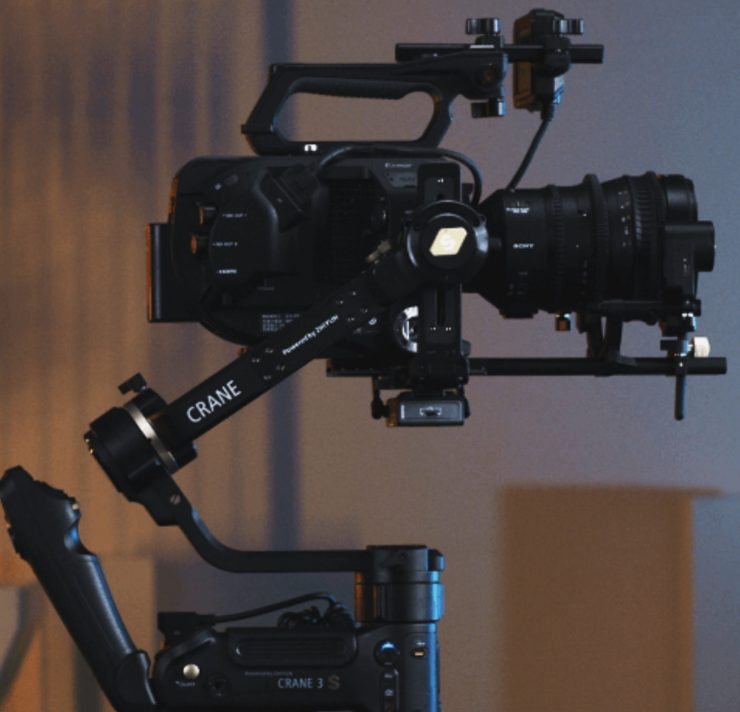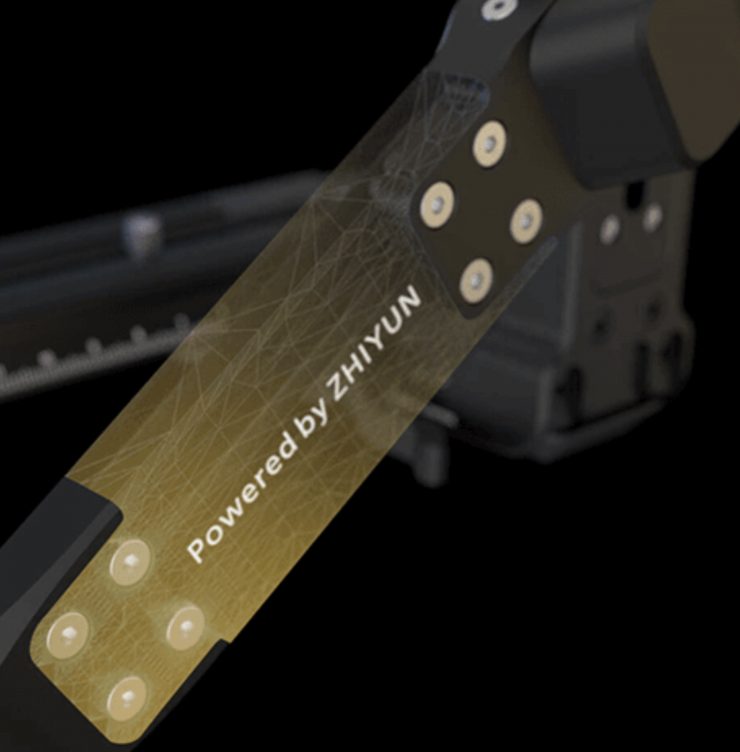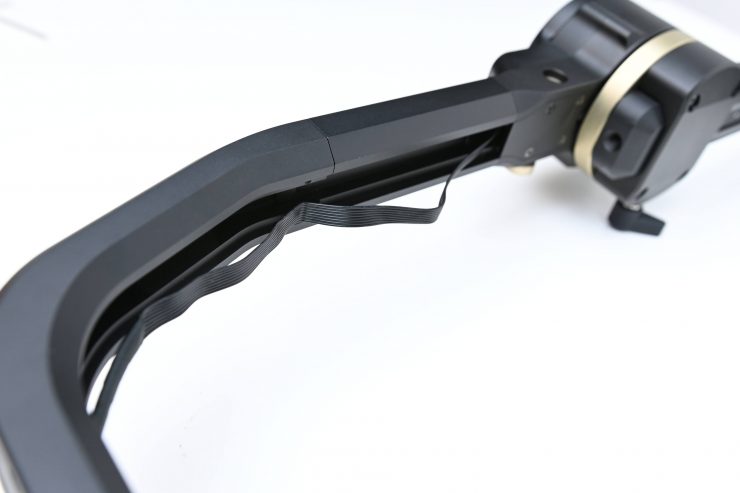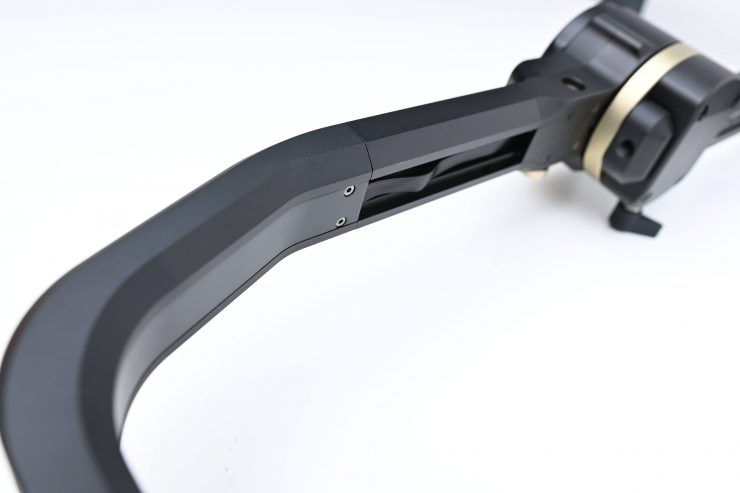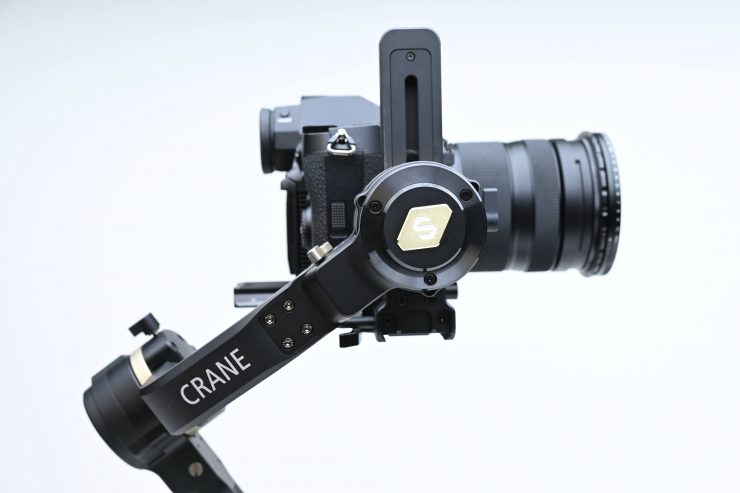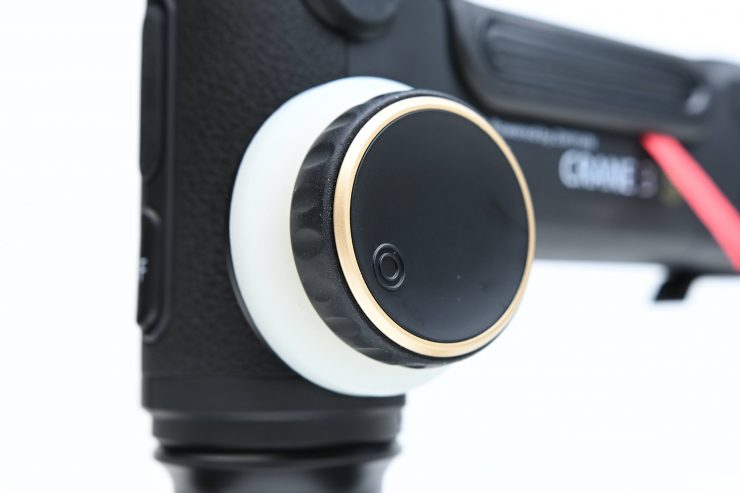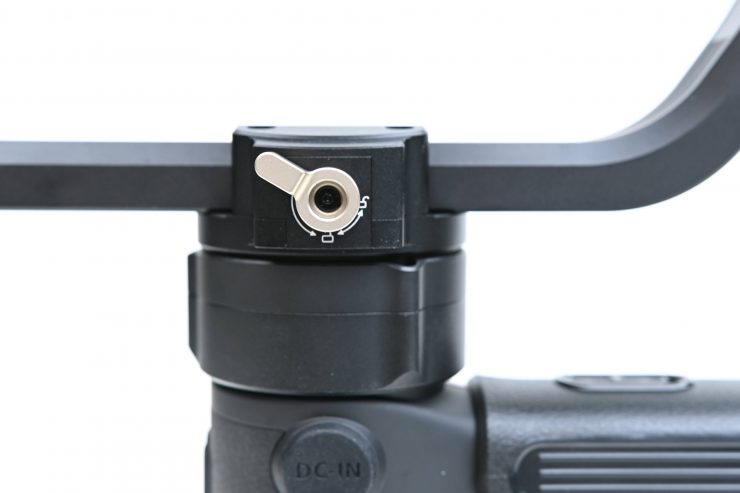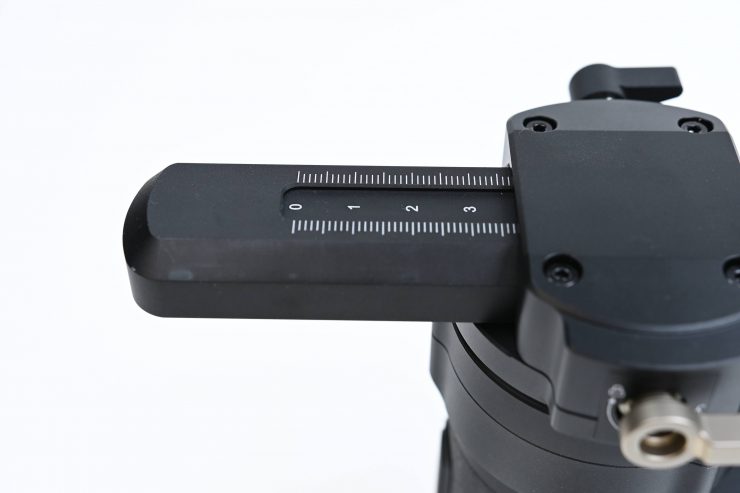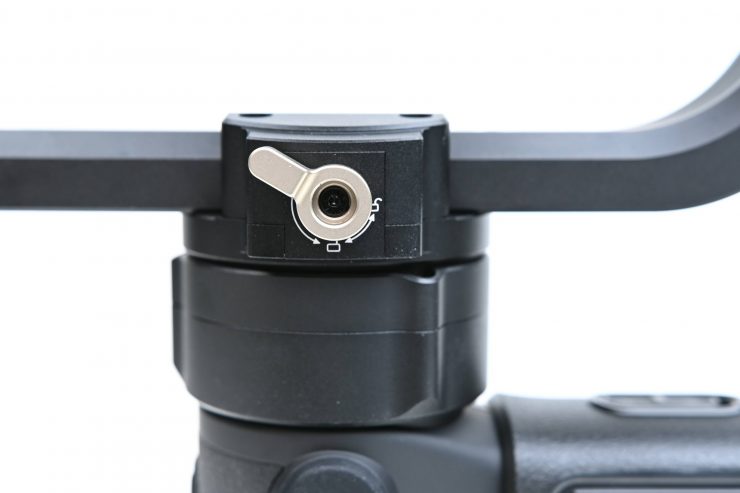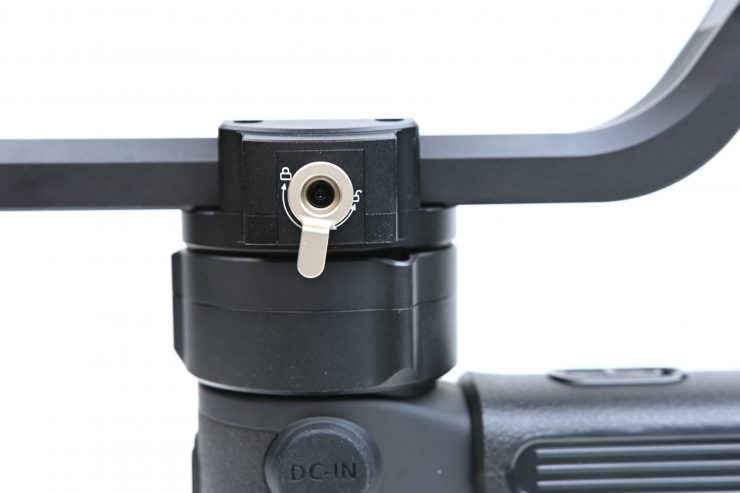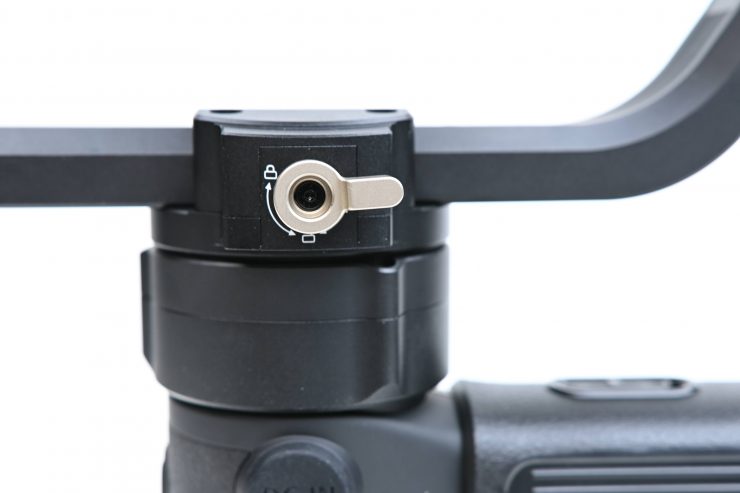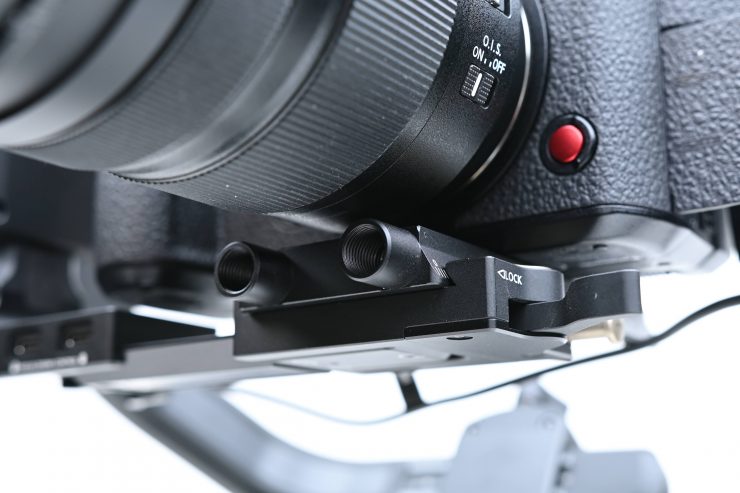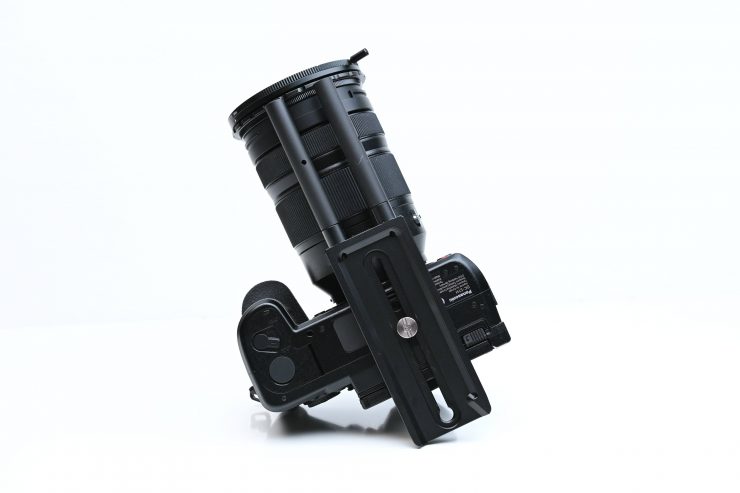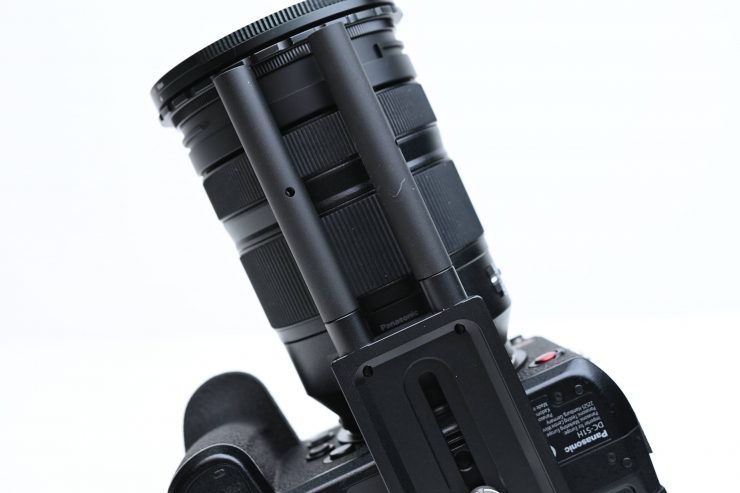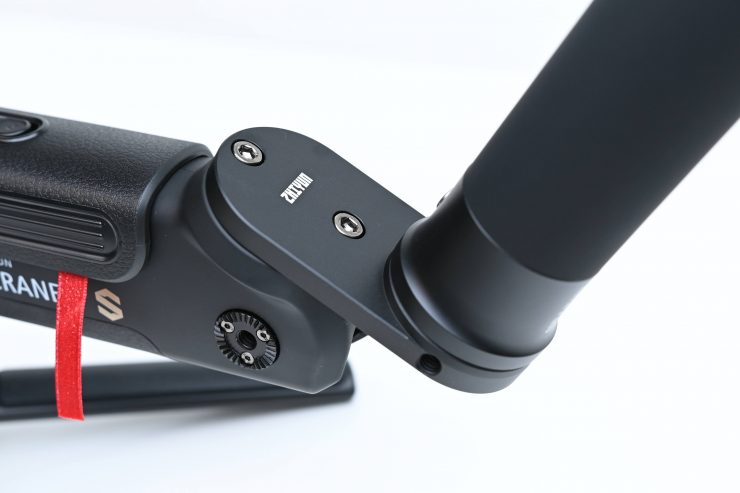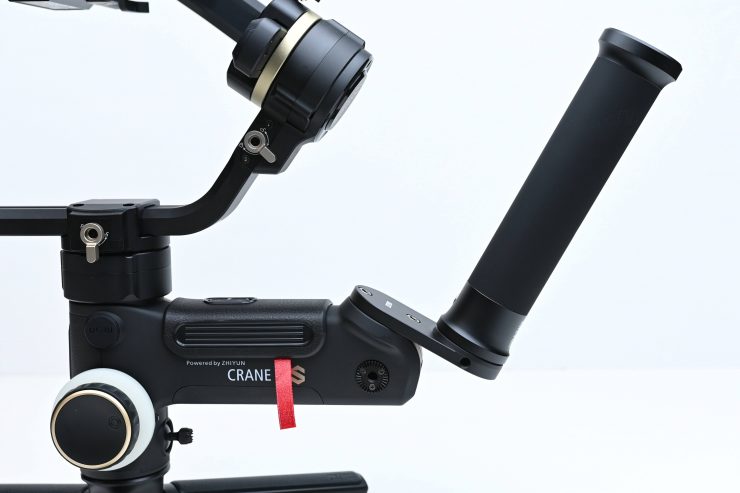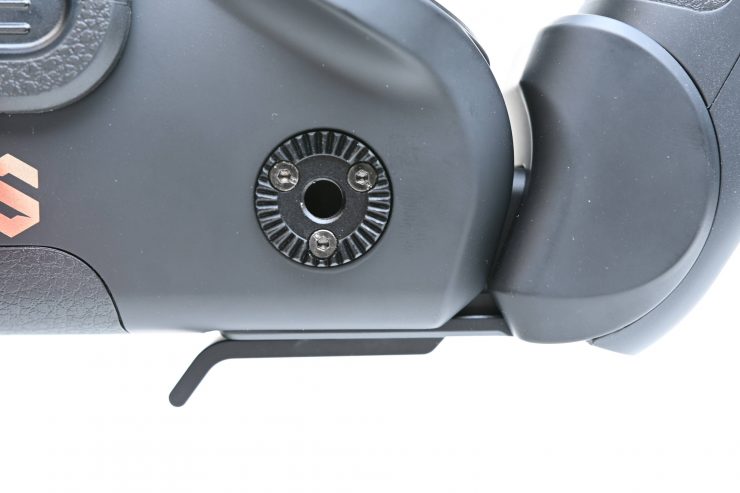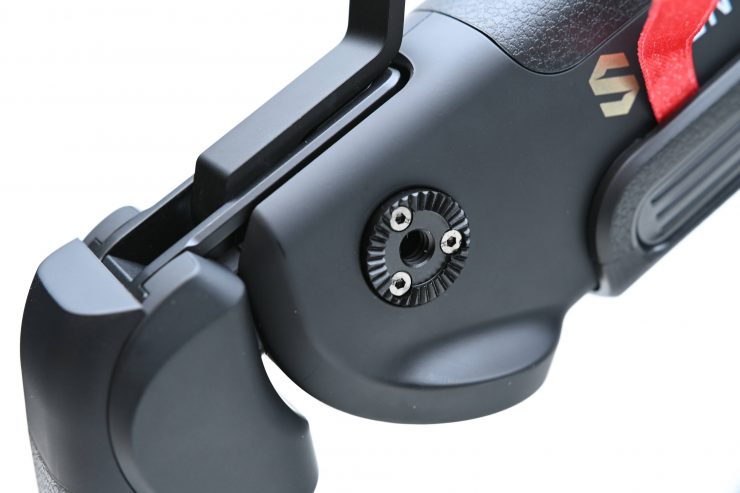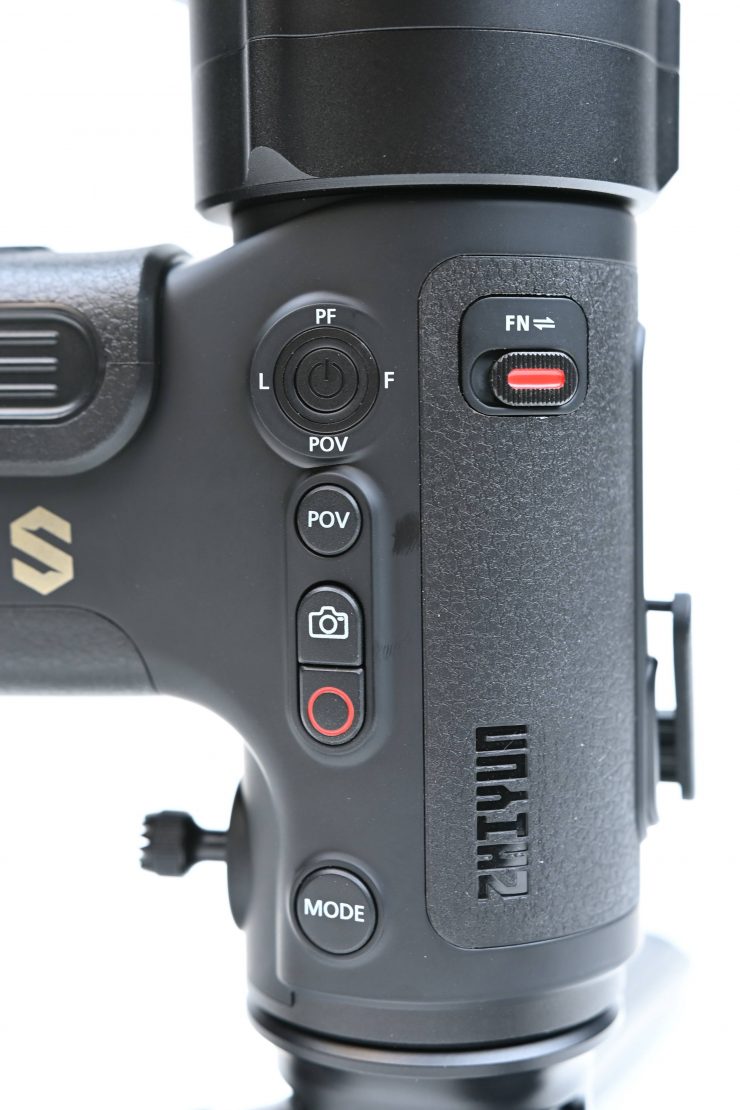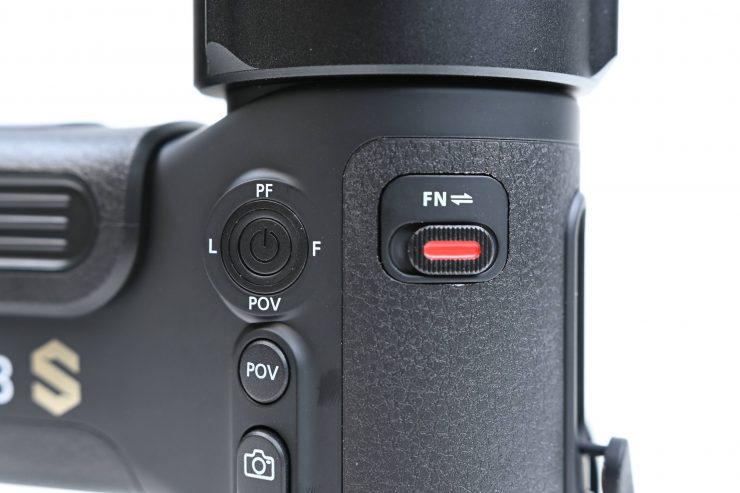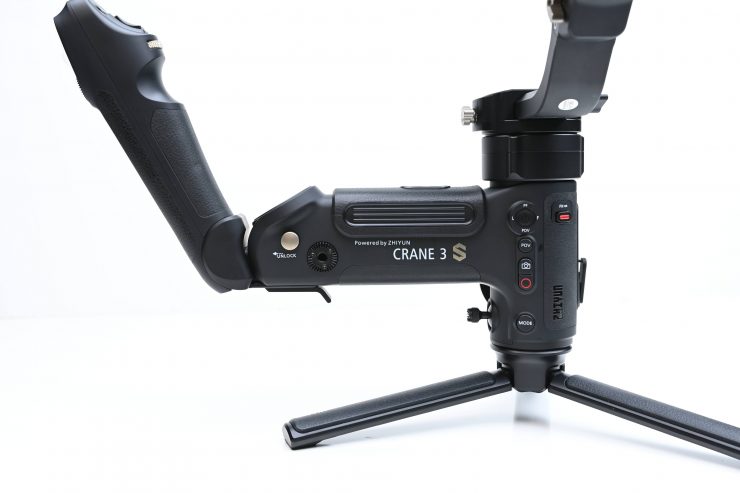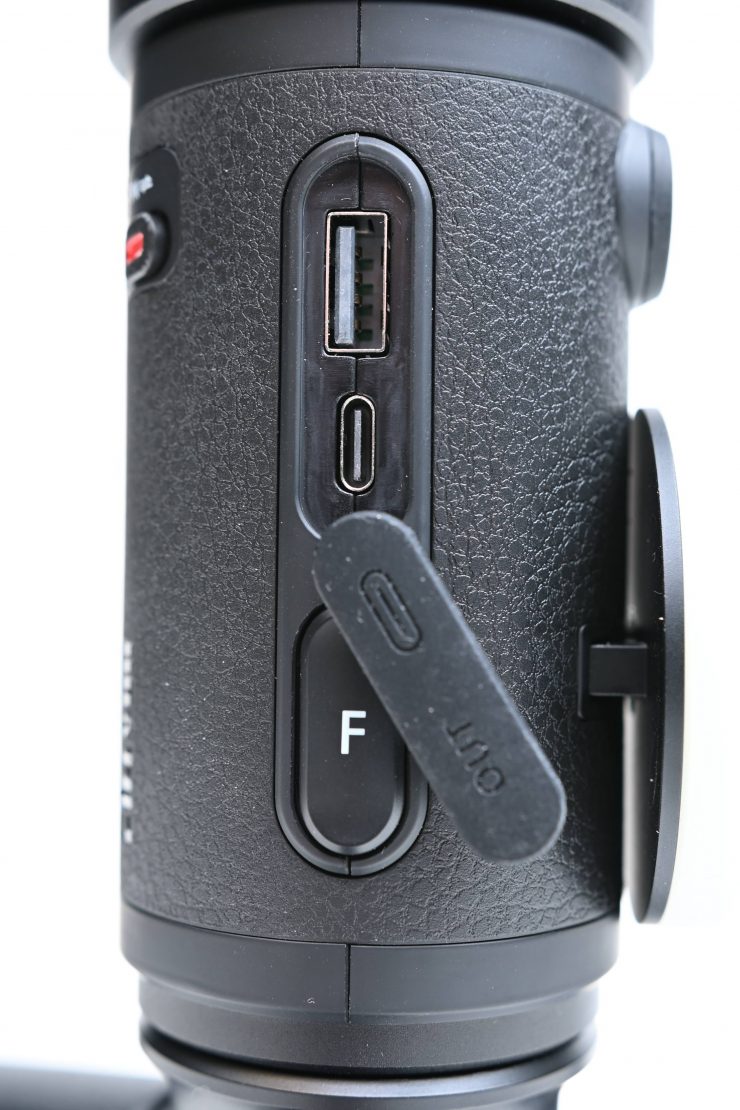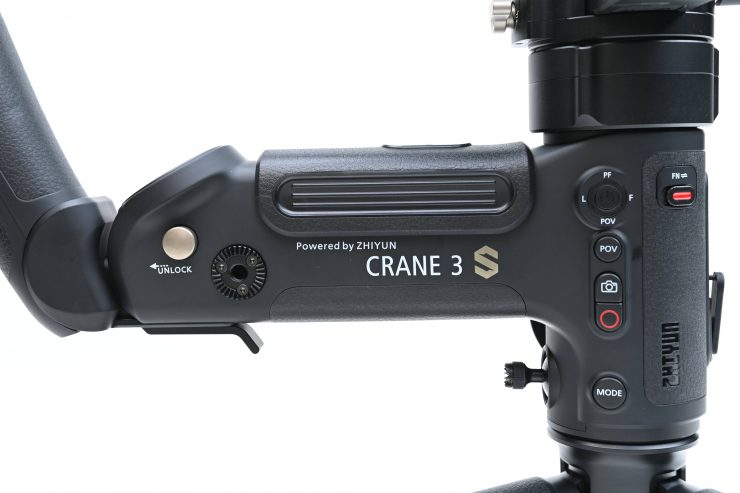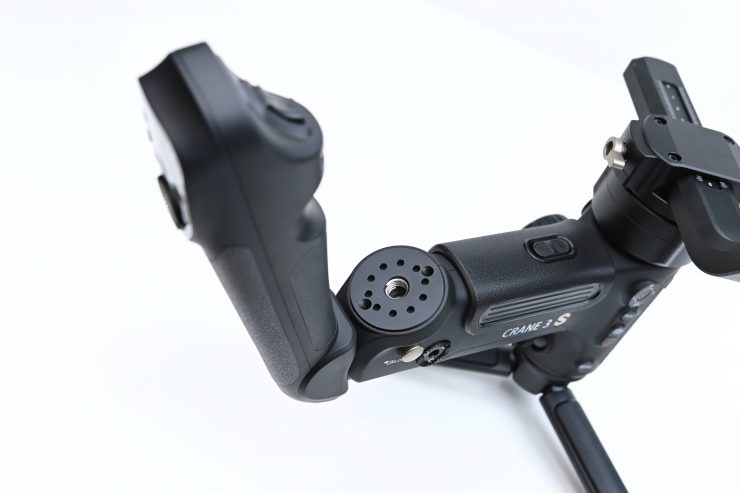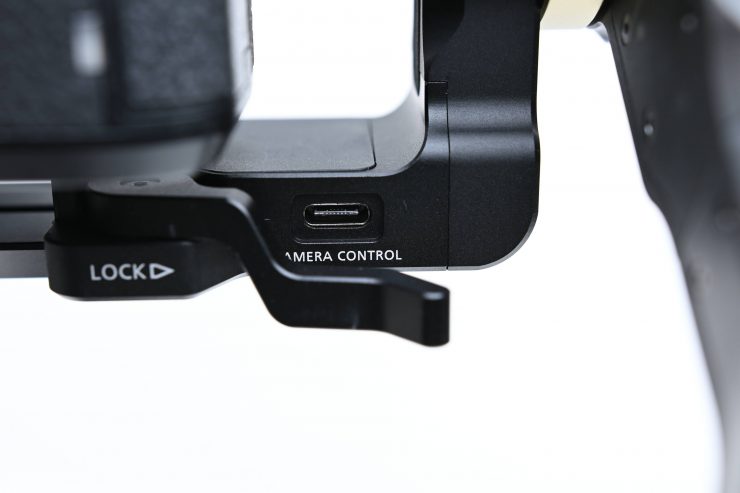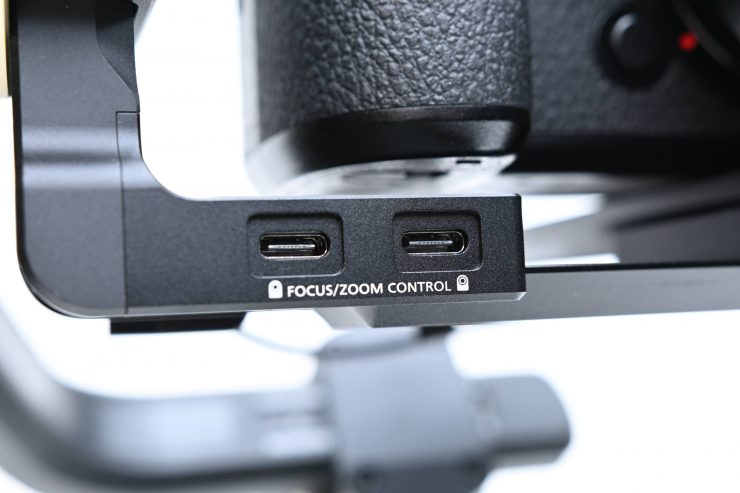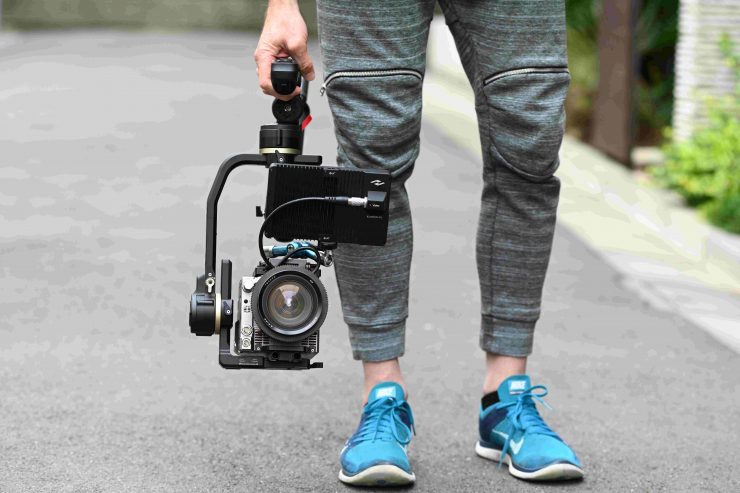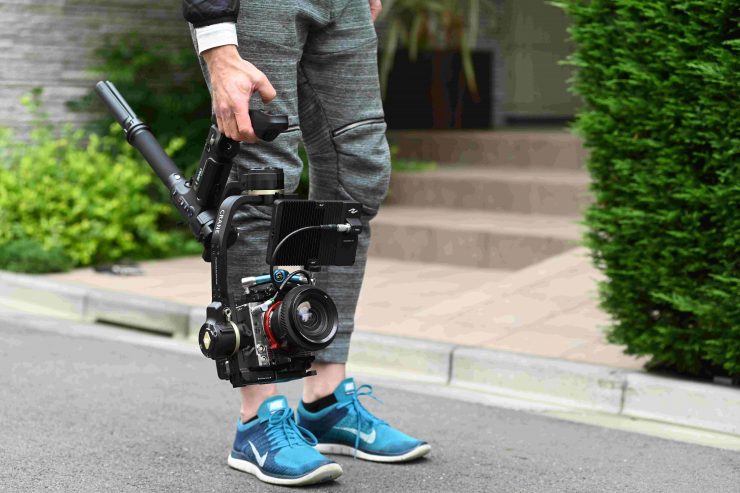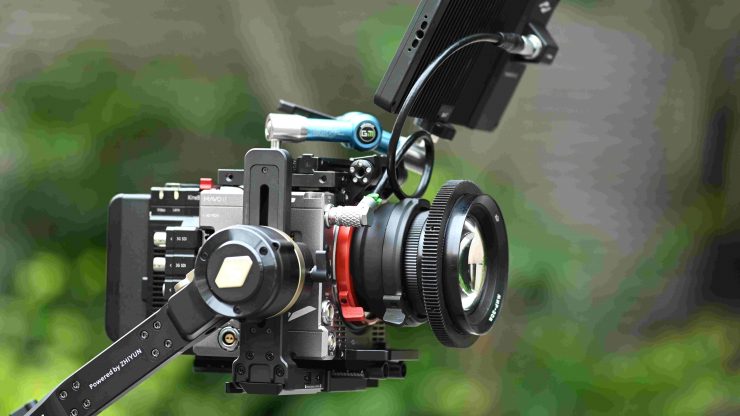
The Zhiyun Crane 3S is the latest addition in the Crane series of gimbals. Zhiyun has taken a lot of what they learned from building the Crane 3 Lab to create their latest flagship gimbal. The biggest selling point of the Crane 3S is that it can handle camera payloads of up to 6.49 kg (14.3 lb).
Zhiyun has forged a strong reputation for making affordable, yet high-quality gimbals, so let’s see if the Crane 3S follows in those footsteps.
It fills a gap in the market
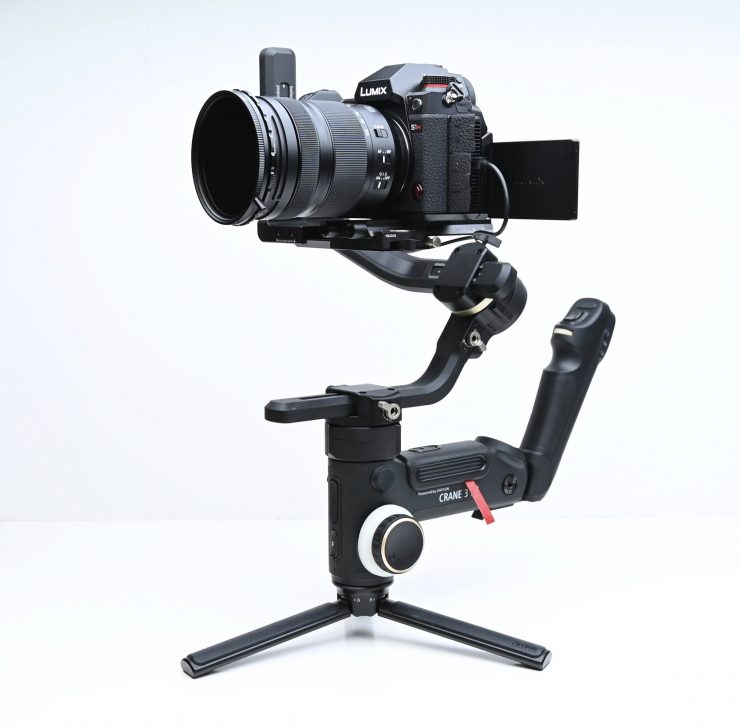
For the last few years, we have had one-handed gimbals that were meant for mirrorless/DSLR cameras and smaller sized digital cinema cameras, or larger gimbals such as the DJI Ronin 2 or Movi Pro that were designed for mid to larger sized digital cameras. There really wasn’t anything that bridged that gap.
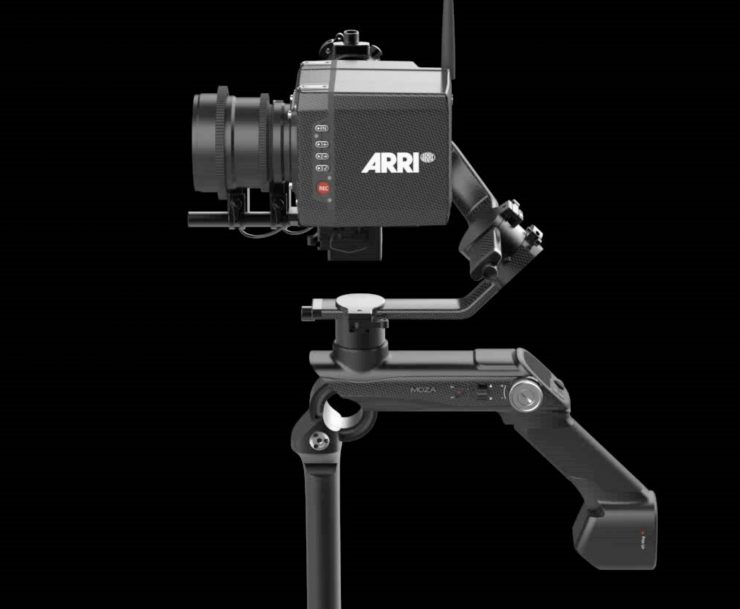
One of the few exceptions was probably the Moza Air X. It is the only other single-handed gimbal that I can think of that could handle payloads of up to 6kg.
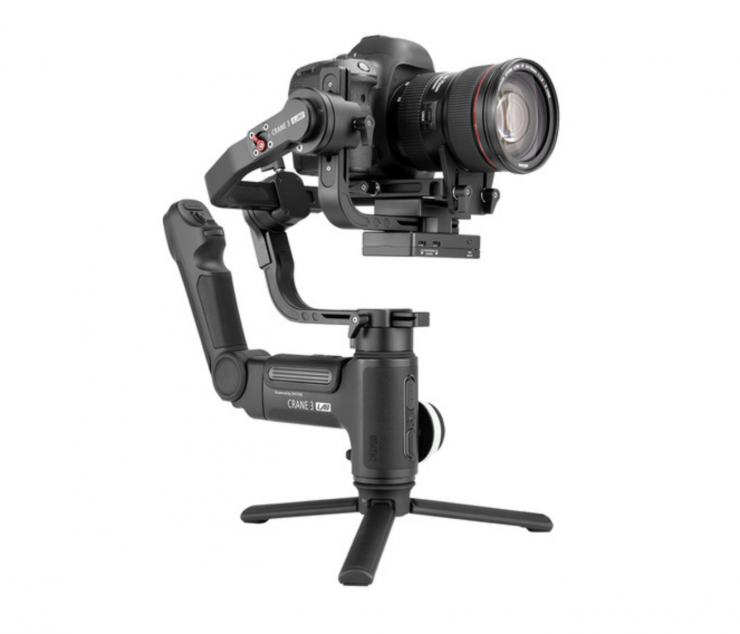
Zhiyun Crane 3 Lab 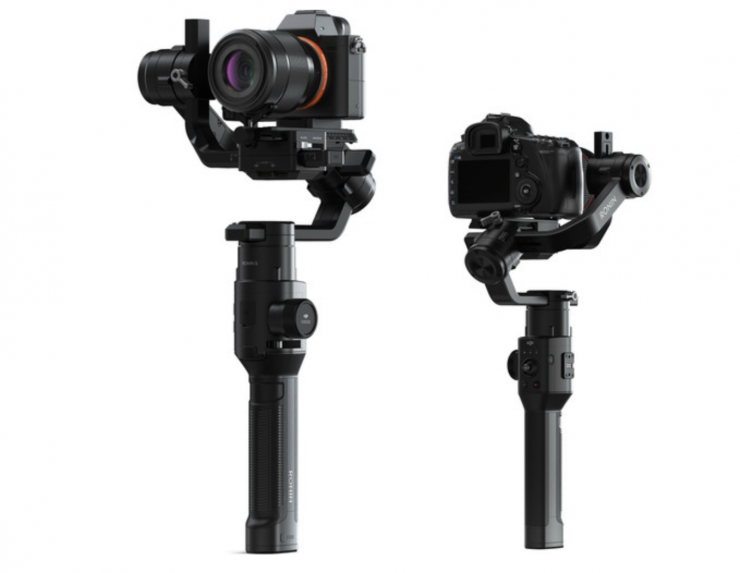
DJI Ronin S 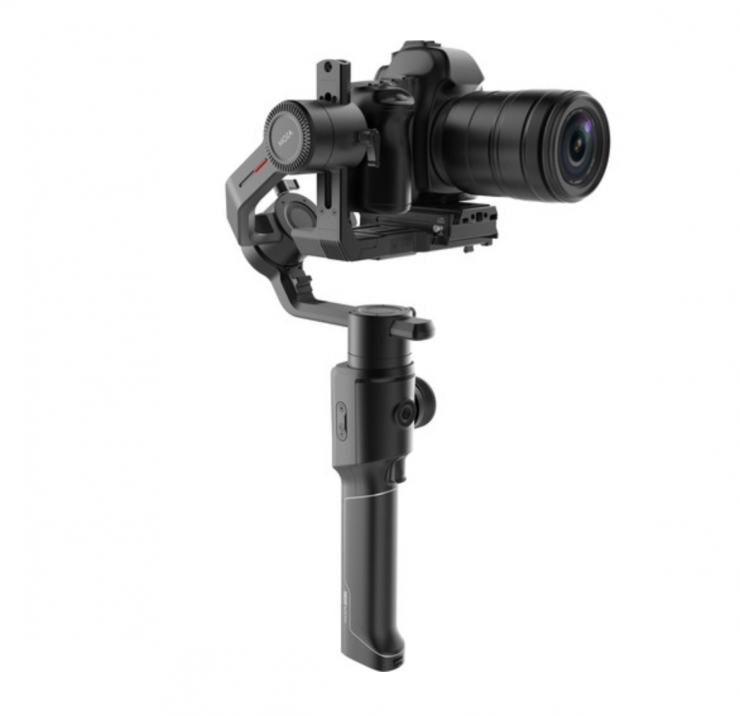
Moza Air 2
Sure, there are gimbals such as the Zhiyun Crane 3 Lab, DJI Ronin-S, and Moza Air 2, which could take smaller sized digital cinema cameras with a little persuasion, but that is not what they were primarily designed to do.
The Crane 3S is bridging a gap in the market between single-handed gimbals and gimbals that were designed to be specifically used with mid to large-sized digital cinema cameras.
With a lot of shooters using cameras such as the Canon C200/C300/C500, Sony FX7/FX9, Panasonic EVA1, and to a lesser extent the Kinefinity TERRA/MAVO and Z-Cam offerings, there is a place for a gimbal such as the Crane 3S.
Yes, you could well argue that running a small to mid-sized digital cinema camera on a one-handed gimbal is counter-intuitive, but we will explore that argument a little later on.
What cameras will work with it?
Compatible cameras include the Canon EOS 1DX, Blackmagic Pocket Cinema Cameras, Canon Cinema EOS, Sony FS & FX series, and RED Digital Cinema Cameras. You could of course also use cameras such as the ARRI ALEXA Mini, Panasonic EVA 1, Z-Cam series, and any of the KInefinity options.
Above you can download the full camera compatibility list. This is list is more to show you what functionality is available when using various camera and lens combinations on the Crane 3S.
Just because you can, doesn’t mean you should
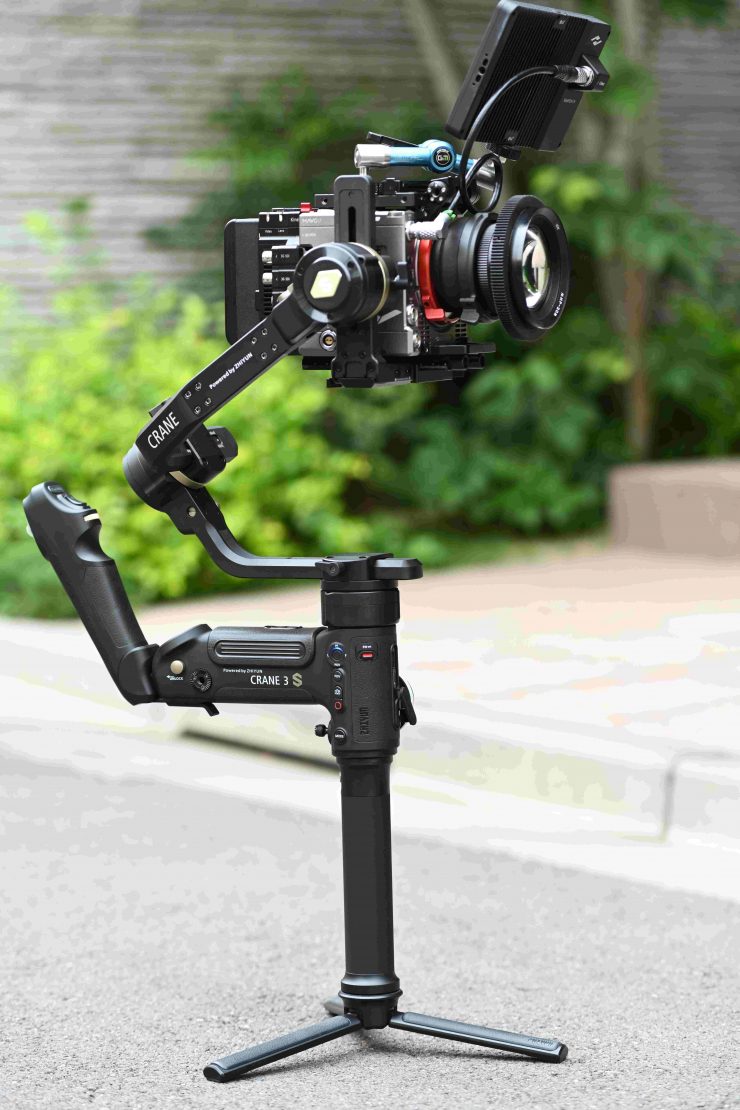
It is all good and well being able to put a small to mid-sized digital cinema camera on a single-handed gimbal, but is it the best idea? That answer really depends on what you want to do with this gimbal. I see it more as a gimbal you would attach to a crane or car mount than a gimbal people will want to use for regular shots.
If you are someone who just wants to get the occasional gimbal shot using their main ‘A’ camera then maybe it makes sense. If you are someone who wants to uses gimbal a lot and needs to hold onto it for extended periods of time then you should steer clear.
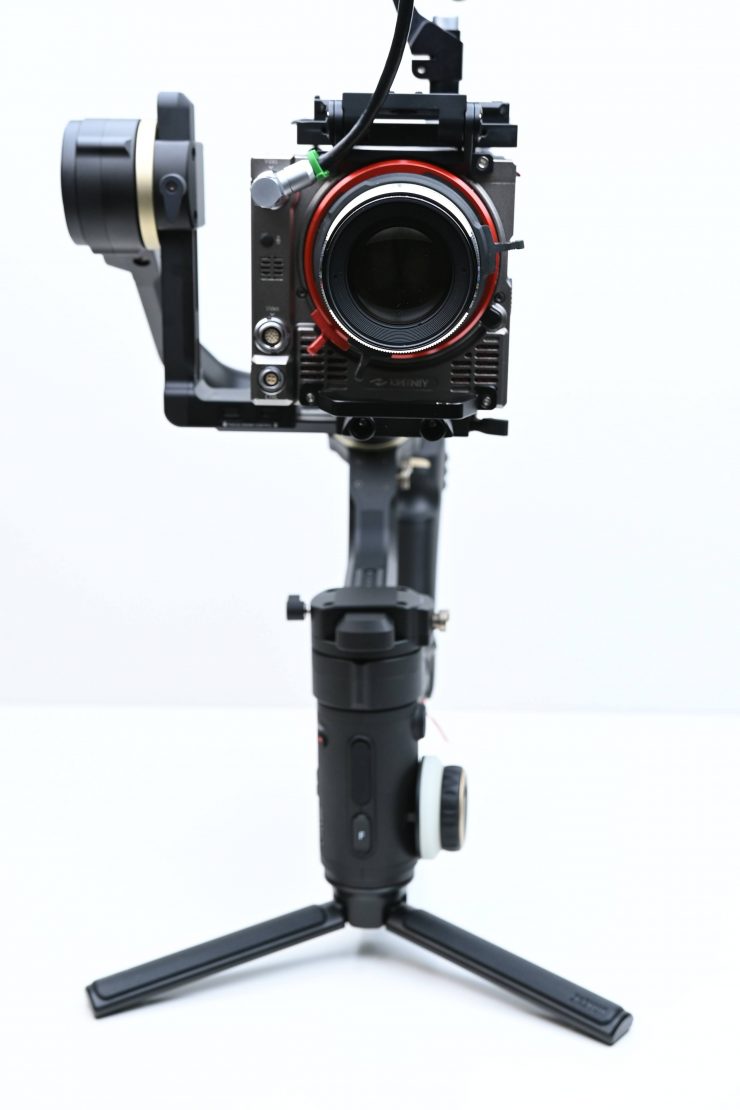
In a lot of ways, the Crane 3S is a niche product and it is only going to appeal to a certain segment of the market, it isn’t for everyone.
Design
Zhiyun took direct design cues from the Crane 3 Lab, and its appearance is very similar. Is it two handles or one handle? Well, it’s sort of both. By designing the gimbal in this way it has allowed Zhiyun to shorten the main handle. The reason behind doing this is to allow the user to get the gimbal closer to the ground for low-angle shots.
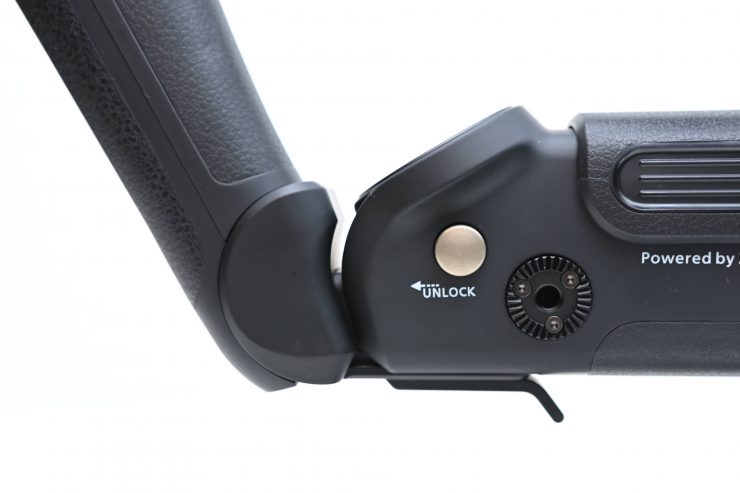
Secondary handle on the Crane 3S 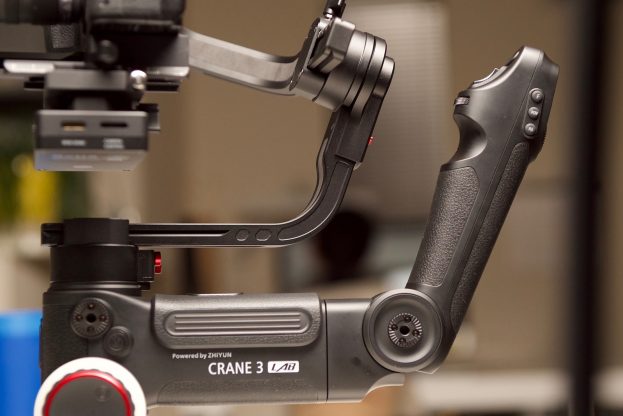
The secondary handle on the Zhiyun Crane 3 Lab
Unlike on the Crane 3 Lab, the secondary handle isn’t fixed in a locked and non-movable position.
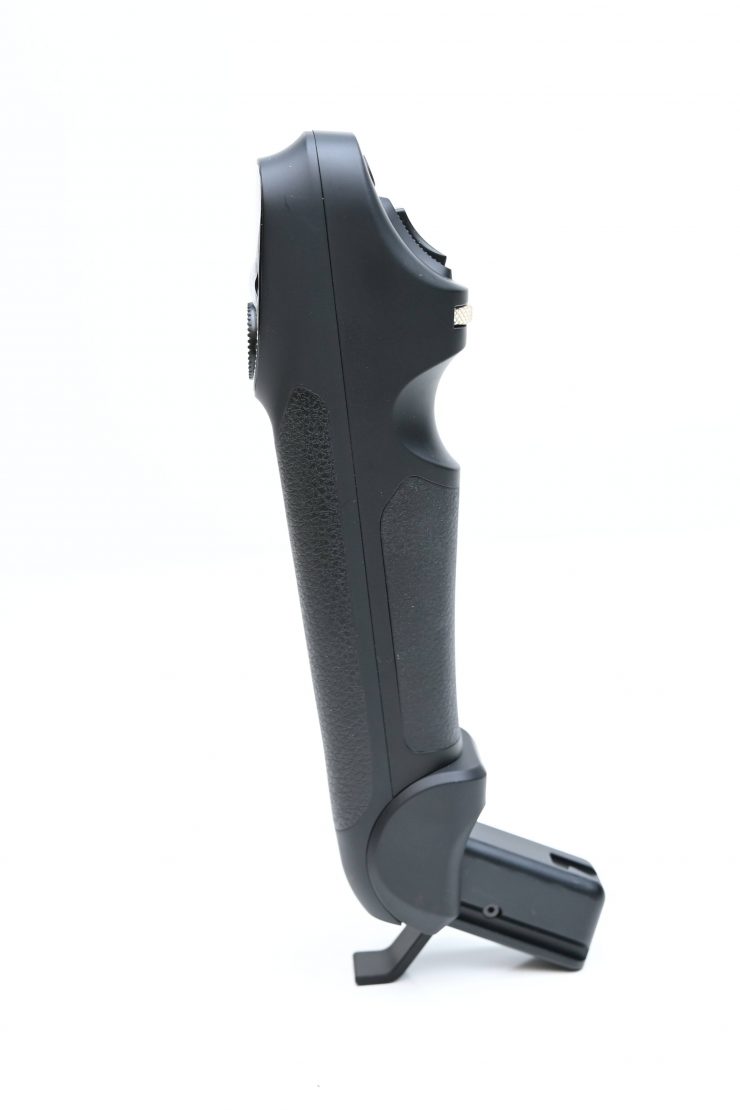
The Crane 3S handle can be detached if you don’t want to use it.
The secondary, removable handle has an electronic connection point that slides into the main section of the Crane 3S. This allows power and control functionality.
It is simple to remove the handle and even easier to put it back on.
Having a secondary handle is supposed to allow the operator to make a smooth transition to and from the low mode. By including the secondary handle you just have to change your hand position depending on whether you want to hold it upright or use it in an underslung position.
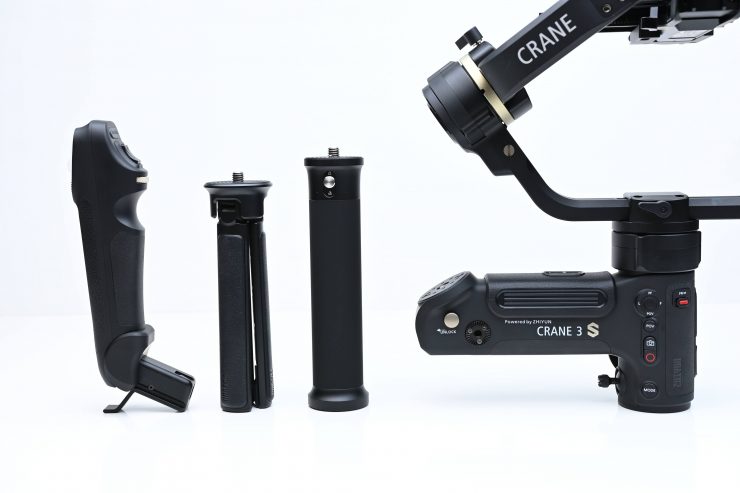
On the Crane 3S, you can use the control handle, the regular handle, or even the mini tripod stand on the back of the gimbal.
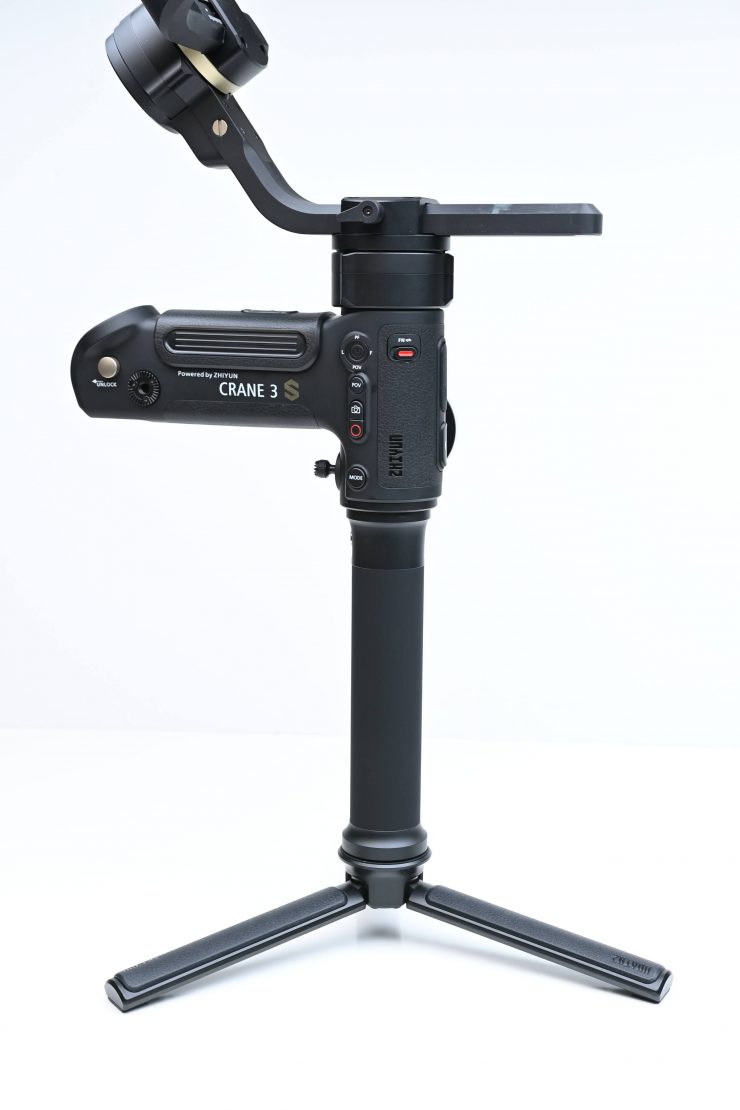
If you use the regular handle as well as the mini tripod legs the gimbal becomes very long.
The big difference between the Crane 3 Lab and the Crane 3S is that the Crane3S has been designed to be a lot more modular, which makes it a lot easier to attach and use with industry equipment.
You need to hold the Crane 3S with two hands, one on each handle. This does take some getting used to and you need to work out which hand goes on what handle. There really isn’t any right or wrong way to position your hands. Whether you like the two handle design is going to very much be down to personal preference. By going with this type of design, at least Zhiyun has given you options as to how you can hold and use the Crane 3S. You may well find that you prefer holding it one particular configuration over another. I will talk more about how it is to actually use and hold later in the review.
If you are used to the Zhiyun Crane Lab 3, then you will feel right at home operating the Crane 3S.
Just like on the Weebill Lab and Crane 3 Lab, the rear arm is also offset so you don’t have the back screen on your camera being obscured when you are shooting. However, with the Crane 3S, Zhiyun has gone a step further and designed the gimbal with a 55° tilted roll axis that provides an even more unobstructed view.
If you need to run an even longer camera, Zhiyun includes an extension arm bracket.
You need to use this extension arm bracket if you are running longer camera and lens packages. There weren’t any instructions for how to install it, so here is what I had to do in steps:
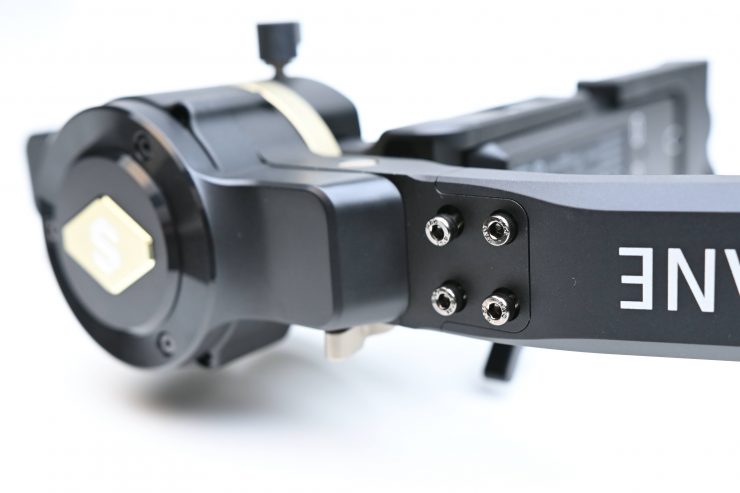
- Undo the four screws on the roll arm.
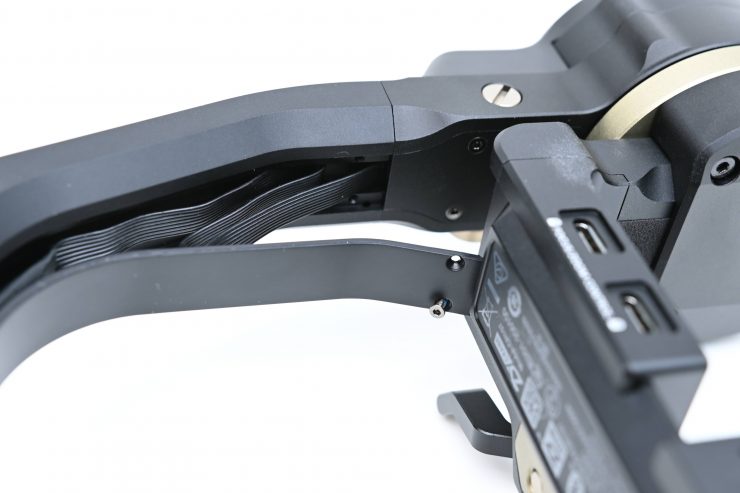
2. Undo the two small screws that hold the cable cover in place
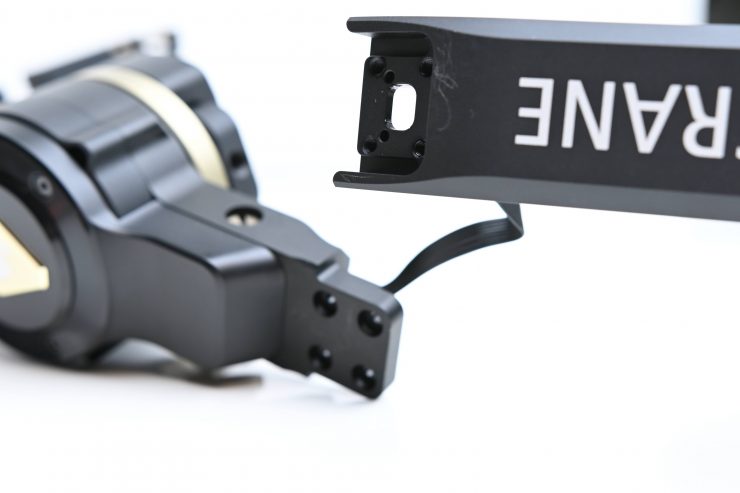
3. Gently separate the arm from the roll axis
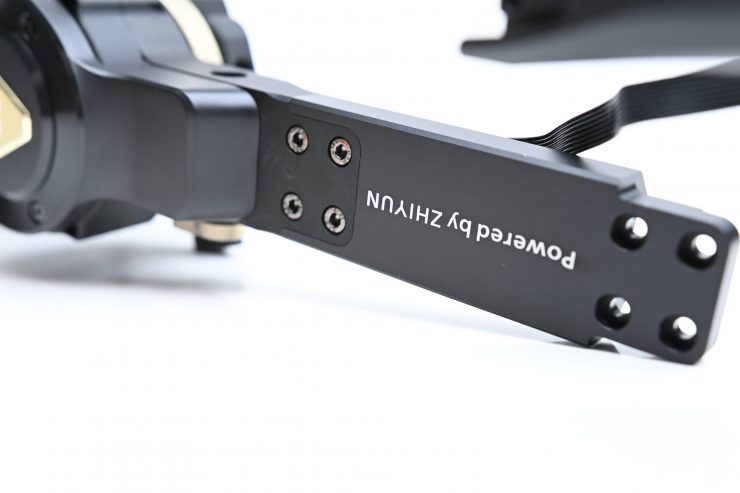
4. Install the extension arm bracket near the roll motor.
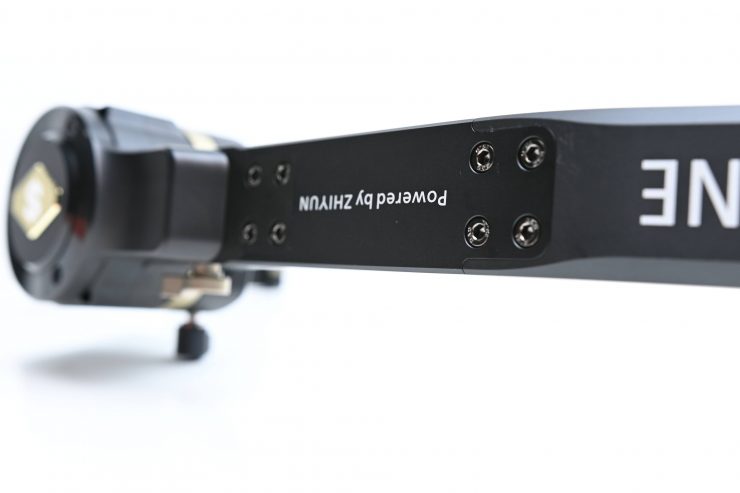
5. Install the extension arm bracket to the roll arm
6. Reinstall the cable cover and tighten the screws
To return the gimbal to its original form you just reverse these steps.
High payload capacity
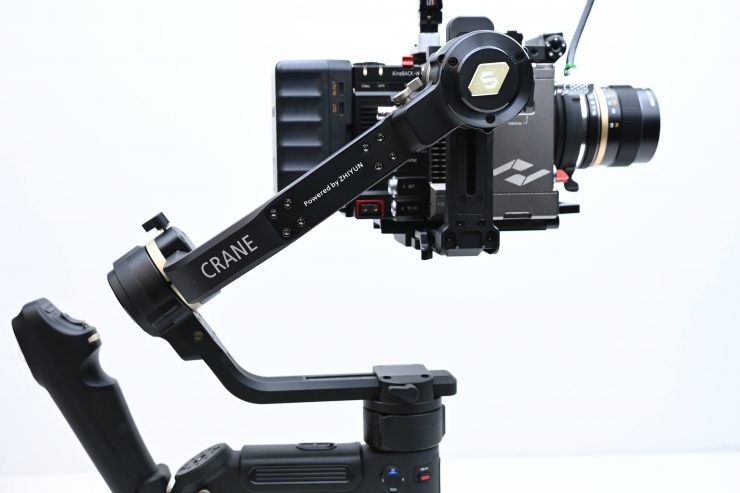
The Crane 3S has a payload capacity of 6.49 kg (14.3 lb). That is a substantial jump from the Crane 3 Lab’s 4.58 kg (10.14 lb) load capacity.
In recent times we have seen companies coming out with one-handed gimbals that can accept some pretty heavy payloads. In my opinion, I think this sort of defeats the purpose of having a compact one-handed gimbal. The heavier the payload, the shorter the time you actually hold it for. I think once a gimbal payload reaches a certain point you are better off with a two-handed design. This is especially true if you are going to try and use something like a Canon C300, Panasonic EVA-1, or an ALEXA Mini on a single-handed gimbal.
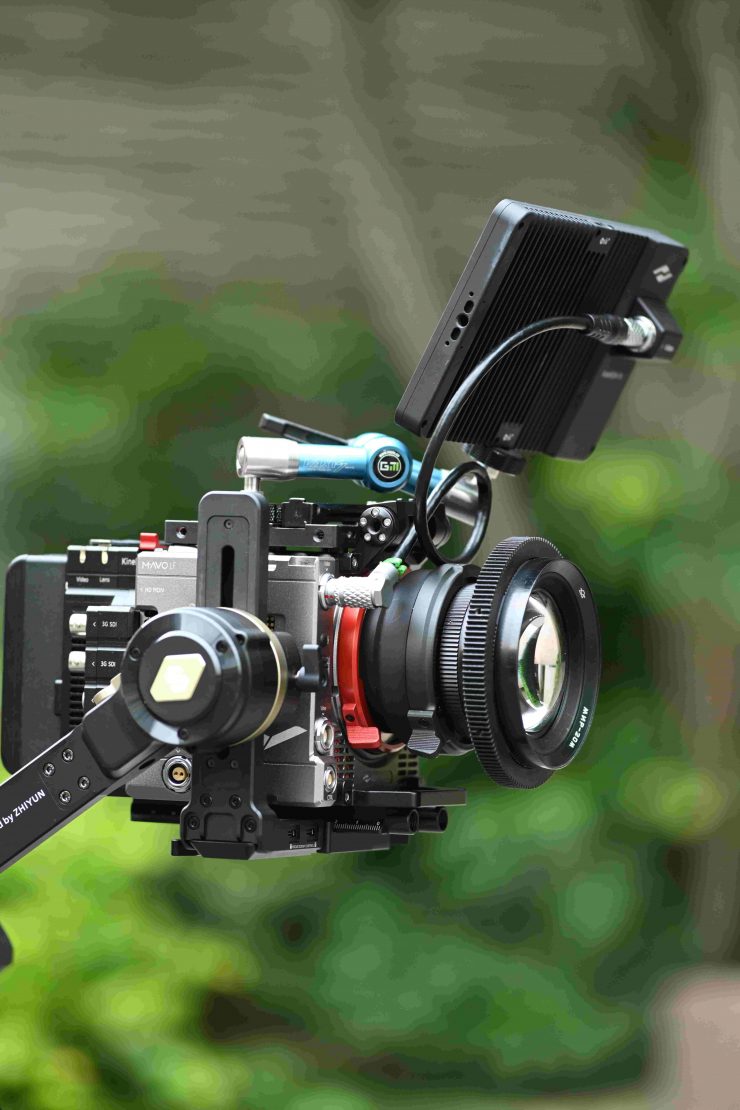
In my opinion, if you are just going to be running a small mirrorless or DSLR set up, there really isn’t a lot gained by buying a larger one-handed gimbal that supports high payloads. Sure, having the added flexibility to run a variety of cameras on a gimbal is great, but you really need to take into account just how long you can operate a single-handed gimbal with a heavy payload.
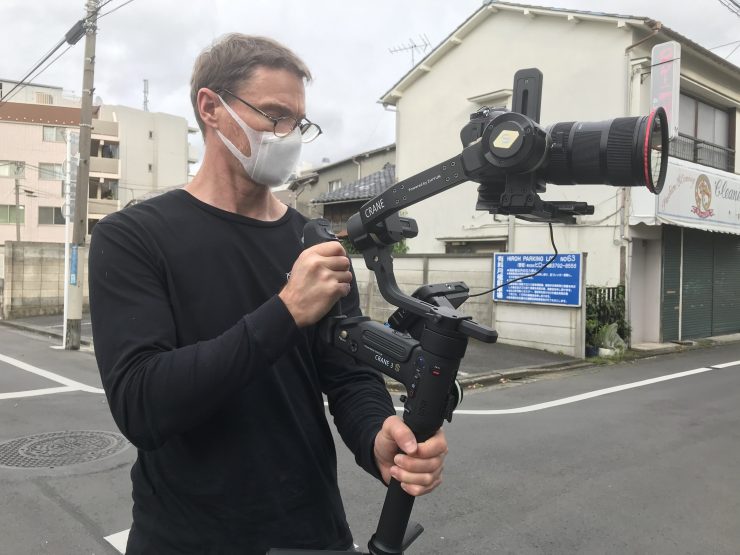
So how does the Crane 3S payload capacity compare to other single-handed gimbals? Below you can see:
| PAYLOAD CAPACITY | |
| Zhiyun Crane3S | 6.49 kg (14.3 lb) |
| Zhiyun Crane 3 Lab | 4.58 kg (10.14 lb) |
| DJI Ronin S | 3.6 kg (7.94 lb) |
| Moza Air 2 | 4.2 kg (9.26 lb) |
| Moza Air X | 6 kg (13.2 lb) |
| Tilta Gravity G2X | 3.63 kg (8 lb) |
Above you can see the payload capacities of some of the other one-handed gimbals that are available. As you can see, the Crane 3S payload capacity is almost 2 kg more than the Crane 3 Lab and almost 3 kg more than the capacity of the DJI Ronin S.
It still has a reasonably small footprint
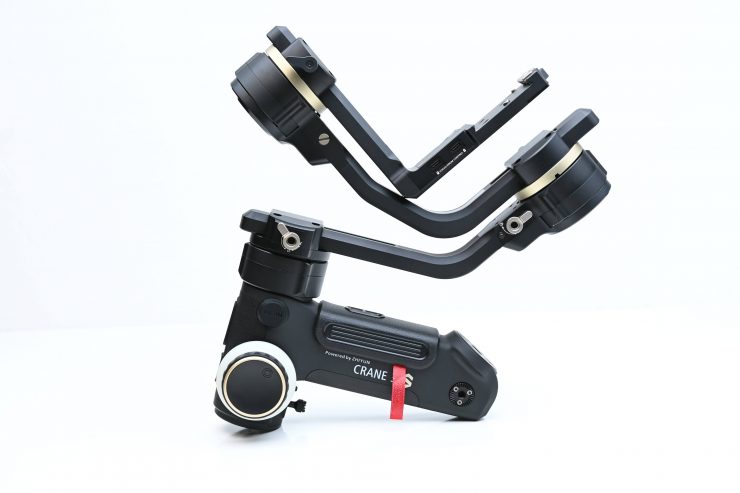
Despite its large payload capacity, the Crane 3S can still be folded down into a relatively small footprint. Look, it is still quite big, but at least the design enables you to fold it down into a workable solution. This makes it a lot more convenient to travel with. This is a big advantage that the Zhiyun models have over other competing gimbals, such as the DJI Ronin-S and the Moza Air 2.
Who is it aimed at?
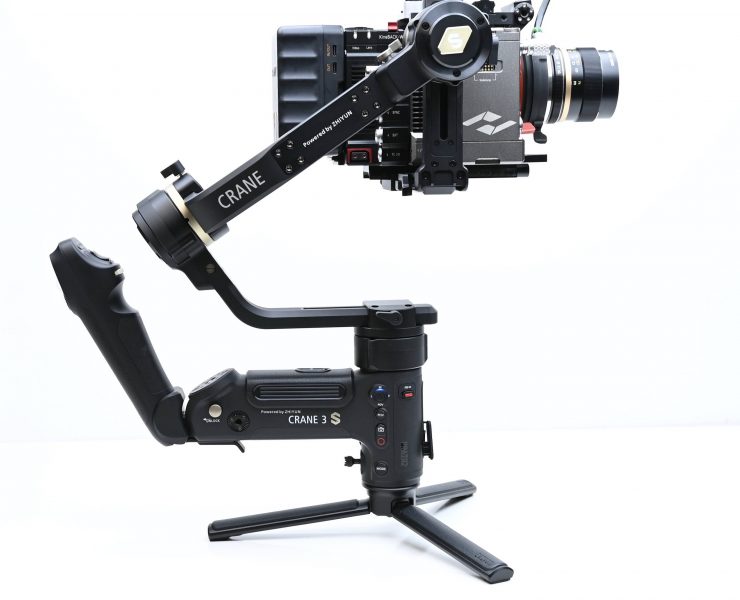
The Crane 3S is aimed at users of small to mid-sized digital cinema cameras and larger mirrorless and DSLR camera packages. Even if you are running a mirrorless or DSLR camera having a larger payload capacity gives you the flexibility to be able to run heavier lenses without straining the gimbal.
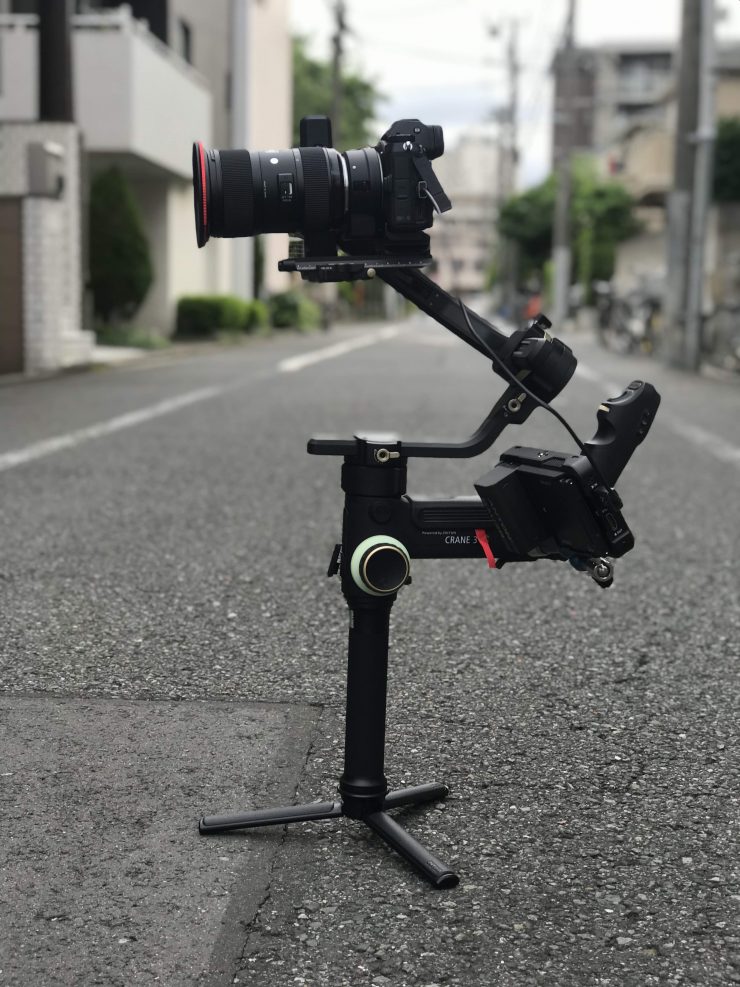
A lot of shooters are happy running mirrorless or DSLR cameras on a gimbal and I’m not quite sure how many would prefer to be using their main camera on a gimbal instead. Running a smaller mirrorless or DSLR ‘B’ camera on a gimbal is just easier for most shooters as they don’t want to carry around a larger gimbal like a DJI Ronin 2 or Movi Pro. Whether the Crane 3S tempts shooters to start using their main camera on a gimbal will be interesting to see.
What do you get?
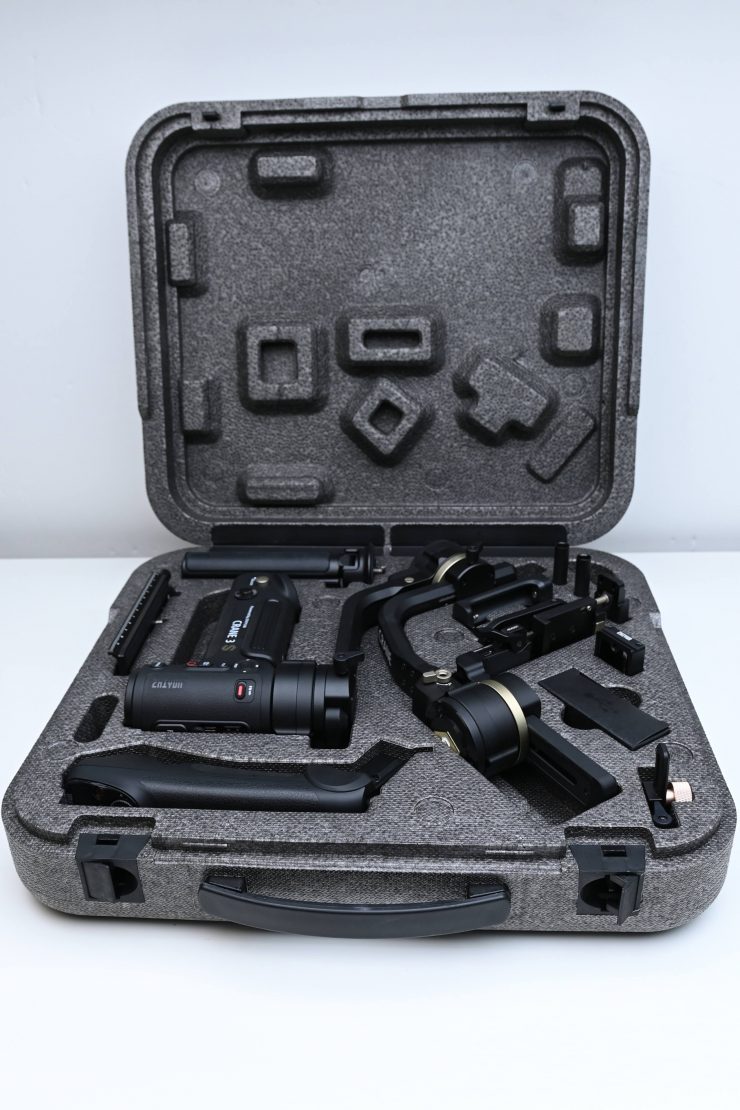
The Zhiyun Crane 3S comes in a foam case that you can carry and store the gimbal in. The case probably isn’t strong enough for air travel, so I wouldn’t recommend you check it in.
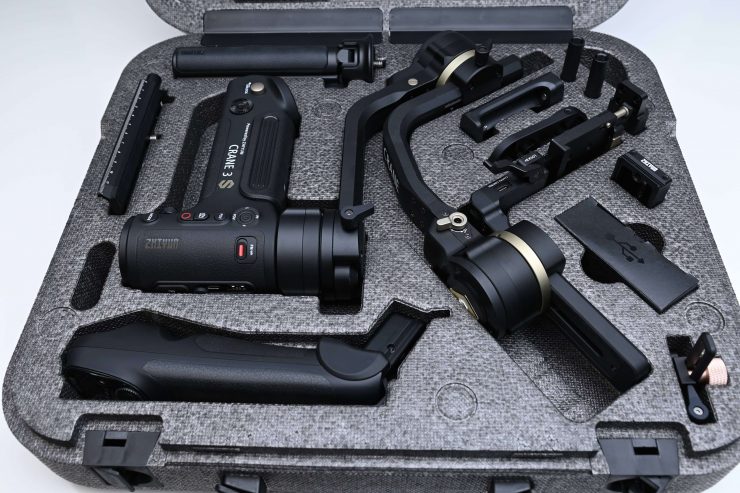
Inside the case, there are custom cutouts for everything that comes with the gimbal. All the components are easy to see and access.
The Crane 3S comes in a case, but once you fit the extension arm bracket it won’t fit back into the case. This is something you should be aware of.
You also get a quick start guide which gives you enough information that you can set up and get your gimbal running fairly quickly.
Along with the actual Crane 3S gimbal, you also get:
- Quick Release Camera Plate
- SmartSling Handle
- 3 x 18650 Battery
- Battery Charger
- Extension Arm
- Handle Adapter Base
- Backing Base
- Tripod
- Lens Support
- Lens Support Rod
- Micro-USB Canon Control Cable
- Mini-USB Canon Control Cable
- USB Type-C Panasonic Control Cable
- USB Type-C to Multi Sony Control Cable
- USB Type-C Charging Cable
- Foam Storage Box
- 3 x 1/4″-20 Screw
- Wrench Set (M1.3, M2.5, M4)
- Limited 1-Year Warranty
Build Quality
The Crane 3S has a similar build quality to the Crane 3 Lab. In saying that, I think Zhiyun gimbals have continued to improve over time and the Crane 3S feels just a little more polished than the Crane 3 Lab.
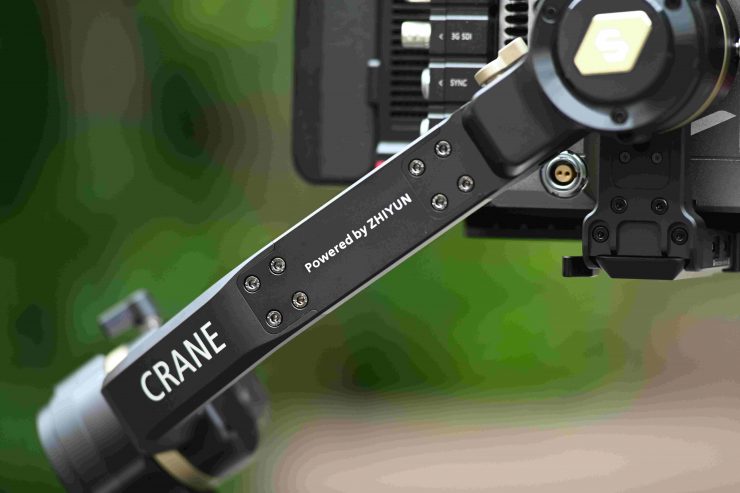
Despite quite a lot of plastic being used, it’s still a pretty heavy gimbal. All the buttons, switches, and knobs are fairly well made. If you are familiar with Zhiyun products you will be more than happy with the build quality of the Crane 3S. There wasn’t anything that I saw that overly concerned me in terms of how it was built and put together. It looks like it would hold up well to the rigors of field use.
The gimbal is heavy
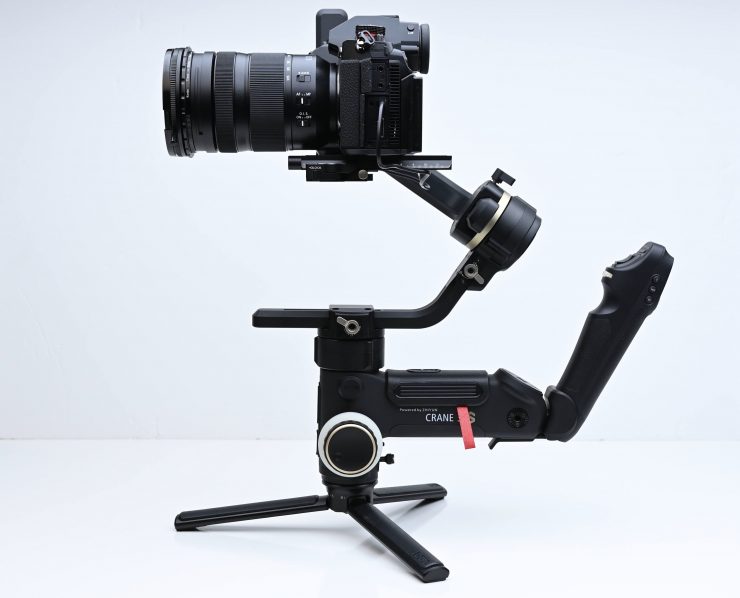
Look there is no way to sugar coat it, it’s a heavy gimbal. Even using a smaller sized digital cinema camera, I wasn’t able to hold onto it for very long before I felt like I wanted to put it back down. This is not a dig at the Crane 3S, I find this to be the case with all of the larger single-handed gimbals.
What you do need to keep in mind is that the Crane 3S (with batteries) weighs in at 2.47 kg (5.45 lb). If you were to attach a camera package with a payload of around 6 kg you are looking at having to carry around 8.5 kg. This is not easy to do and you will find yourself putting the gimbal down within a few minutes.
How much does it weigh compared to other gimbals? Below you can see:
| GIMBAL WEIGHT | |
| Zhiyun Crane3S | 2.47 kg (5.45 lb) |
| Zhiyun Crane 3 Lab | 1.9 kg (4.19 lb) |
| DJI Ronin S | 1.86 kg (4.1 lb) |
| Moza Air 2 | 1.6 kg (3.53 lb) |
| Moza Air X | 1.4 kg (3.08 lb) |
| Tilta Gravity G2X | 1.79 kg (3.95 lb) |
Batteries & Run Time
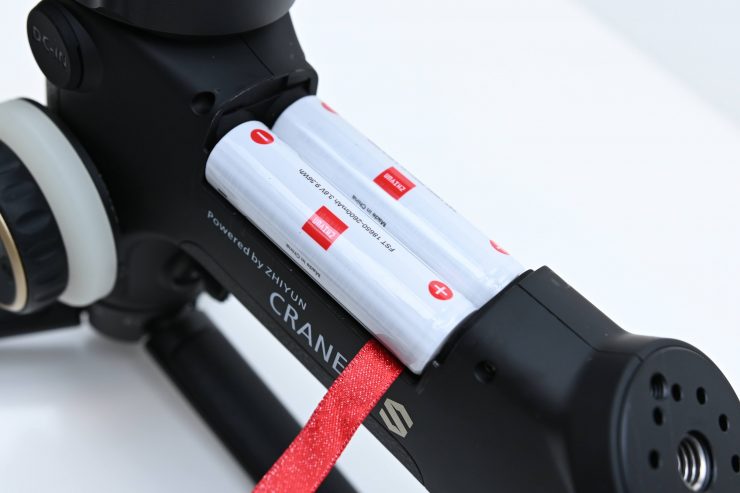
The Crane 3S requires 3x 18650 batteries, and Zhiyun claims a run time of up to 12 hours. Based on my experience using the gimbal I found that the battery life was good and it should easily get most shooters through an entire day.
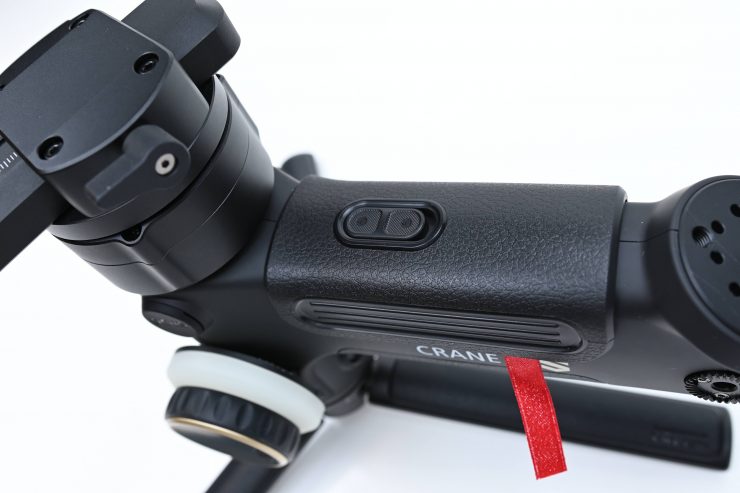
To remove the battery cover, there is a little locking switch on the top that you need to unlock.
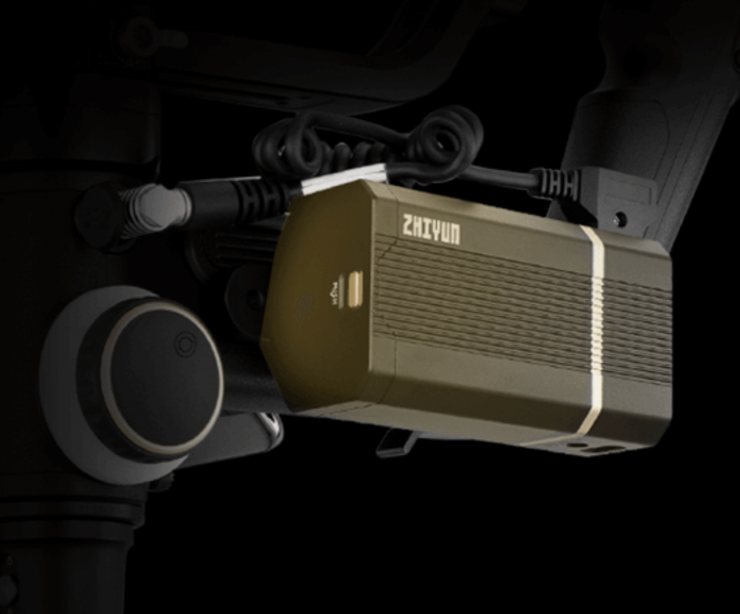
If you want longer run times, Zhiyun also now sells an optional TransMount PowerPlus Battery Pack that can house 6x 18650 batteries. It also serves as a compact yet fast-charging power bank for your devices.
The TransMount PowerPlus Battery Pack will run the CRANE 3S for up to 18 hours. For camera combos over 3kg, Zhiyun recommends you use the PowerPlus Battery Pack.
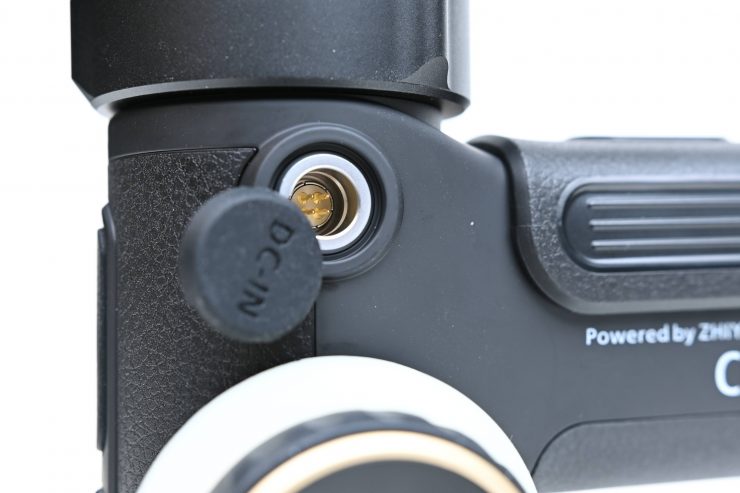
There is a DC input on the gimbal where you attach the TransMount PowerPlus Battery Pack.
Double Locks
Just like the Crane 3 Lab, the Crane 3S Lab features a latch on each axis that you can lock off to make balancing the gimbal a lot easier. Zhiyun has actually slightly redesigned this system and now it features double locks.
The double locks are a necessity because you don’t want a heavy camera and lens package falling down or to one side when you are trying to balance it.
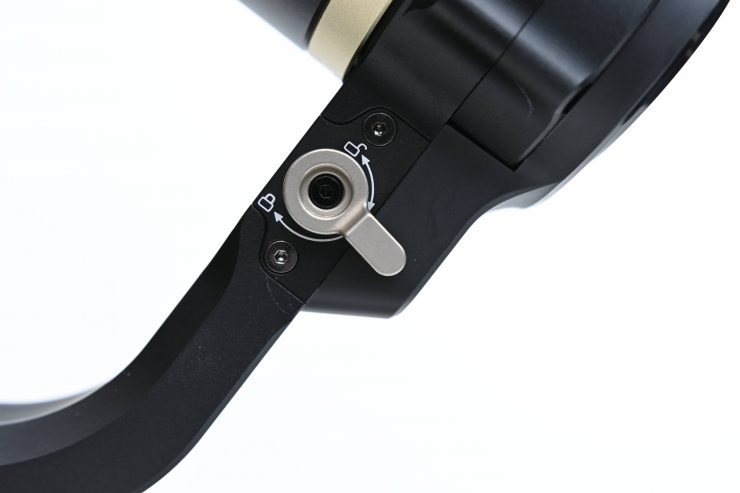
The nice aspect about these latches is they aren’t made out of plastic, they are anodized aluminum and are not going to break.
What I do like is if you are traveling around from location to location you can lock all of the axes and keep your camera on the gimbal. Then when you turn up you can simply unlock them and you are ready to go. This saves you a ton of time as you don’t have to re-balance the gimbal every time you move locations. If you are like me, I tend to leave a camera on a gimbal as I find it too time-consuming to be taking a camera on and off all the time. This is one of my favorite features of the Crane 3S.
In saying all of this, it is just as easy to take your camera off as it has a quick-release plate. This allows you to put the camera back on the gimbal without needing to do any major rebalancing.
Balancing
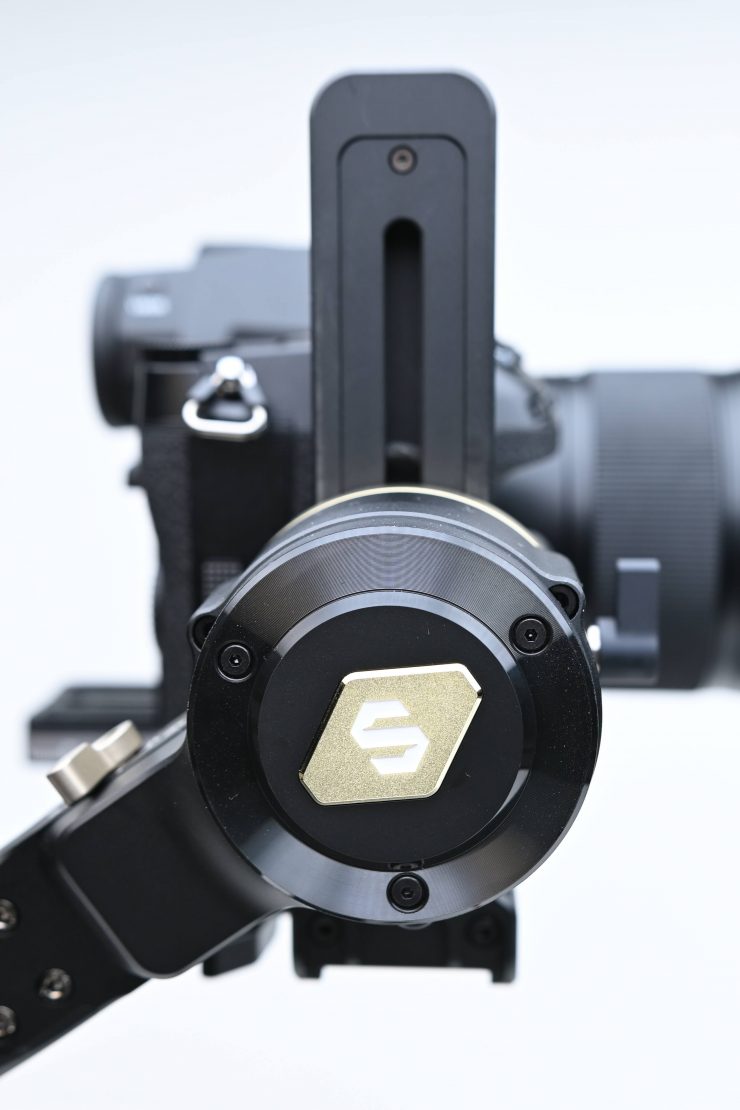
Here is where I found the Crane 3S to be very hit and miss. Balancing smaller camera and lens packages like a Panasonic S1H or a BMPCC 6K is relatively easy and straight forward, but larger cameras are a different story.
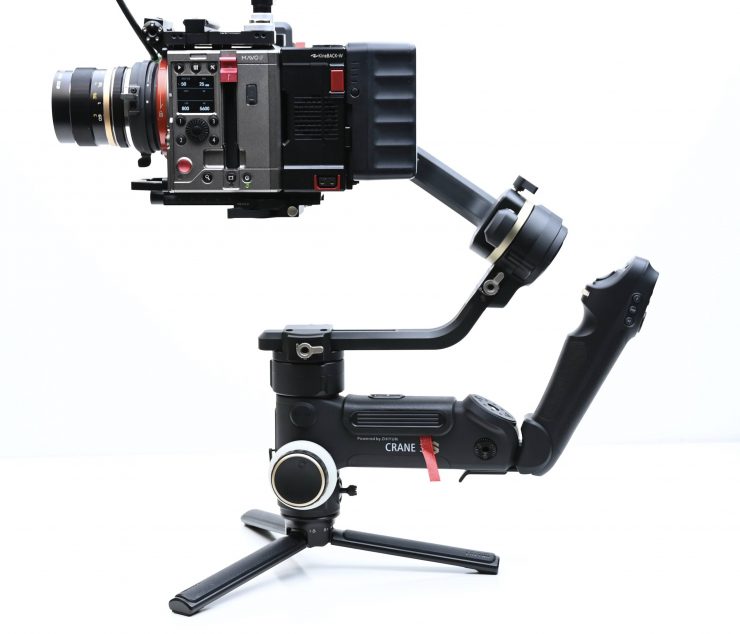
I tried balancing a Kinefinity MAVO LF on the Crane 3S and it was a little difficult. With larger cameras, the balance needs to more exact and things make the whole balancing process take longer.
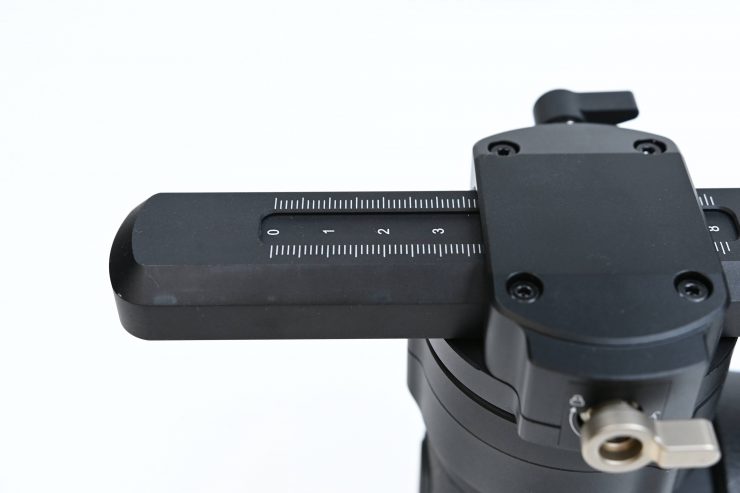
The other problem I found is that once you have a heavier camera placed on the gimbal, it becomes extremely hard to move the adjustment arms. They require you to use so much force that it is hard to make subtle micro-adjustments.
With bigger, heavier cameras it is also hard to make adjustments because you have all of the weight and inertia of the camera fighting against you.
Quick Release Plate
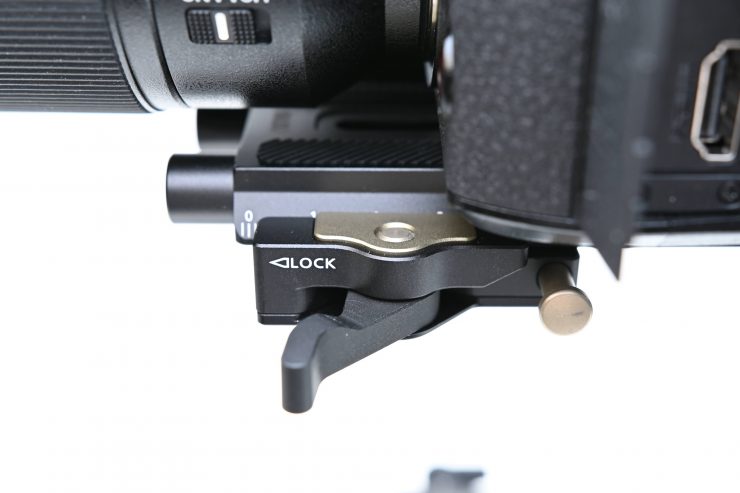
The Crane 3S utilizes a Manfrotto quick release plate. Once you attach the plate to your camera you just slide it on and then lock it in place. The locking mechanism hs been slightly redesigned and it is better than the one found on the Crane 3 Lab.
The redesigned plate also lets you attach the included rods straight to the front of the plate.
No built-in stand
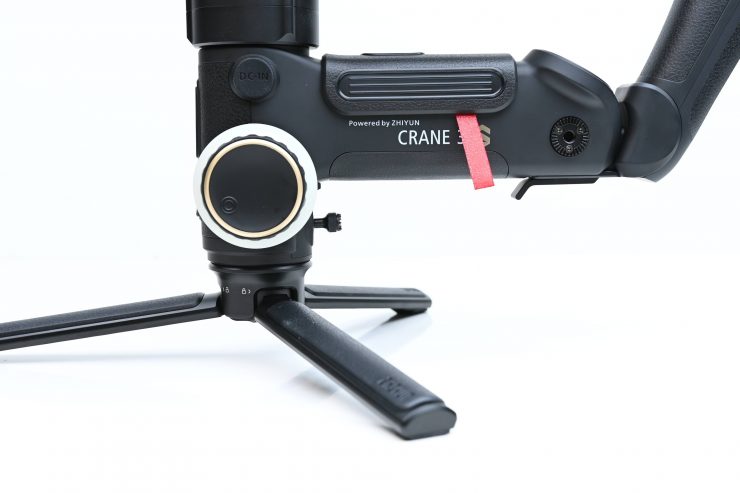
The Crane3S comes with a small removable stand that you can attach to the bottom of the gimbal. This allows you to put the camera and gimbal down onto a flat surface.
This removable stand is quite small and the problem I found is that it is awkward to unfold quickly, especially when you need to do it with one hand.
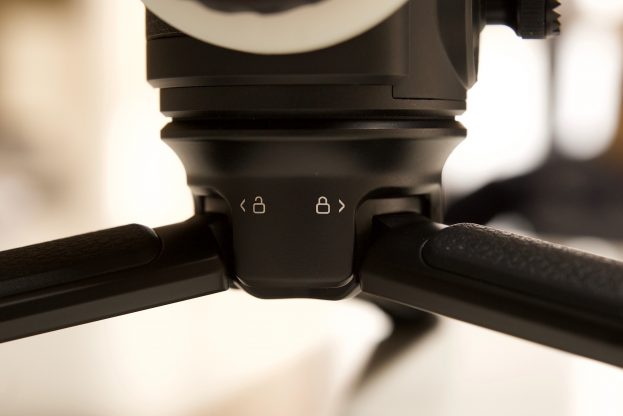
In a nice touch, Zhiyun has labeled the tripod stand so you know exactly which way it needs to be turned to remove it or tighten it onto the gimbal. I like little touches like this because it shows me that the design team is paying attention to small details.
Mounting Points
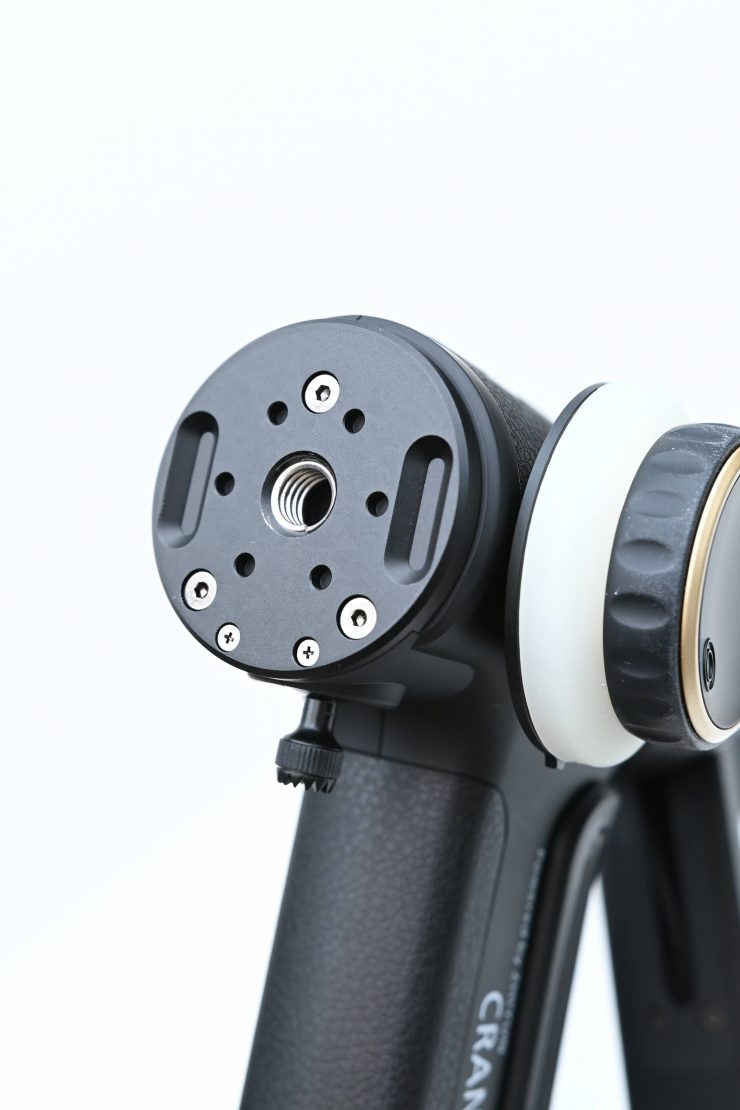
The Crane 3S has a 3/8″ mounting point on the base of the main handle. This is where you can attach the included Mini Tripod Legs, or put it onto a light stand, pole or anything else that you want to use.
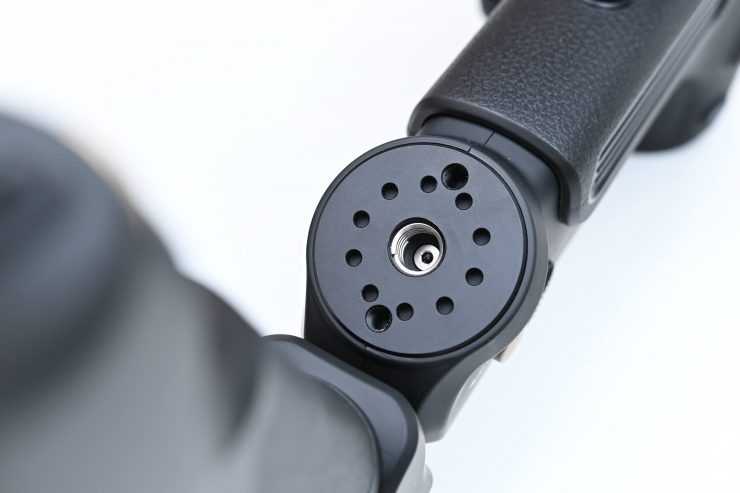
There is also a 3/8″ mounting point towards the back of the gimbal. Here there are also two 1/4 20″ tapped mounting holes.
Zhiyun also includes a mounting bracket that you can attach with two screws to this same mounting point. This allows you to mount other accessories or move the long handle further back.
Near the back of the gimbal, there are also two rosette style attachment points (one on the left side and one on the right side)where you can attach the optional TransMount Phone Holder with Crown Gear or a monitor arm or other accessory. This is also a 1/4-20″ tapped hole.
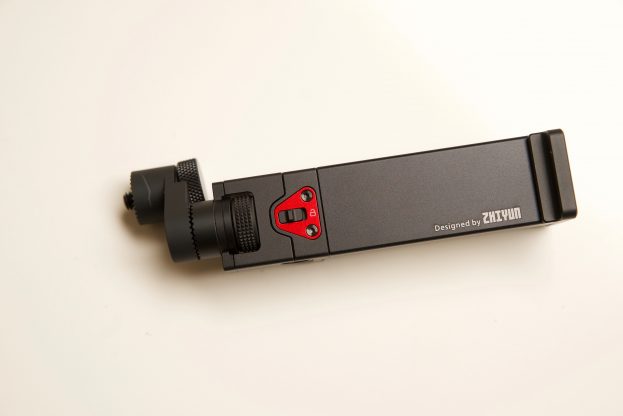
The optional TransMount Phone Holder with Crown Gear really is a must if you are purchasing the Crane 3S. I still can’t work out why they made this an optional accessory and charge $49 USD for it. It really should have been a standard accessory that is included with the gimbal.
Wireless Image Transmission
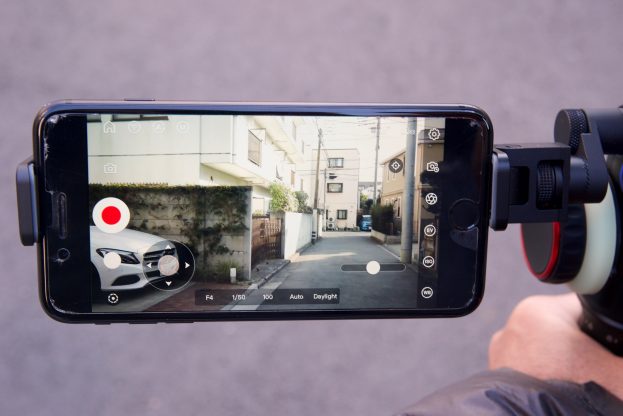
First introduced on the Weebill Lab, wireless image transmission is also as a standard feature on the Crane 3 Lab, However, it is not standard on the Crane 3S. The in-built wireless was one of the main features for me that put the Weebill Lab ahead of its competition (when it worked). I hate rigging up an external monitor to a gimbal and I can’t for the life of me judge exposure, framing and focus from a tiny screen on the back of a camera. This is especially true when shooting in bright sunny conditions.
With no built-in wireless transmitter, you need to buy the optional module to be able to do real-time monitoring, framing, and camera control (although this depends on the camera).
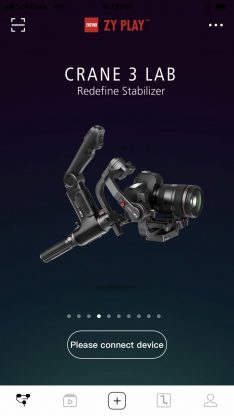
The image is wirelessly transmitted over wi-fi so all you need to do is download the Zhiyun Play app and then fire up your smartphone. The way it works is that you need to connect an HDMI cable from your camera to the optional image transmission module.
The only problem is, and they never show you this in the marketing material, you need to have both the camera control cable and an HDMI cable connected up between your camera and the gimbal. This means you have a myriad of cables sticking out everywhere. You also need to be aware that with certain cameras, if you attach an HDMI cable or use a camera control cable, the back LCD screen turns black.
The Zhiyun Play app allows you to adjust and control your gimbal as well as control quite a few functions on your camera (this depends on what camera you are using).
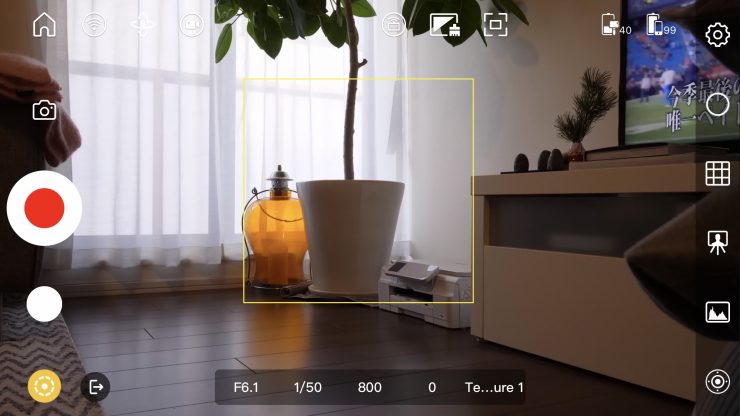
One of the features in the Zhiyun Play app is the image tracking. This feature allows you to draw a box around an object and then the gimbal will track that object no matter which direction the gimbal is moving. I found the image tracking to be pretty disappointing. It seems to only work when subjects are in the middle of the frame. As soon as they start moving toward the side of the frame the tracking seems to stop.
Physical Controls & Layout
If you are familiar with other Zhiyun gimbals you will find that the basic control layout is very similar to the Crane 3 Lab, but some controls have been repositioned.
Now, this is both good and bad. The good aspect is because of the way the Crane 3S has been designed, you are probably going to be holding it with two hands anyway. The bad aspect is that by positioning the controls and status screen on the rear handle, Zhiyun is forcing you to use it.
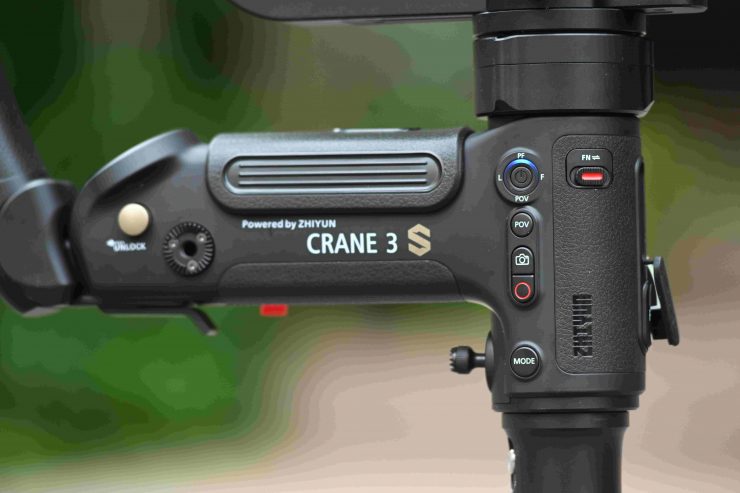
If you want to use the joystick control or focus wheel then you are almost being forced into holding the gimbal with one hand on the rear handle and one on the main. If you want to just hold onto the main handle you won’t be able to easily change camera settings such as f-stop etc.
In saying this, if you did want to just hold onto the main handle or not use the rear handle, you could attach your smartphone and then make all of your changes there. That way you don’t have to touch any of the controls on the rear handle.
You may also find that you will have to hold the rear handle with whatever is your dominant hand. For example, if you are right-handed and you try and hold the rear handle with your left hand you might find it awkward to make changes or operate the buttons.
I do, however, like that the display screen is on the rear handle because it makes it a lot easier to see. Having the screen on the main handle doesn’t make a lot of operational sense because you can’t really see it easily.
On the rear handle, there is a small display, record button, GO button, buttons for changing the camera setting modes such as ISO and f-stop, and a dial for navigating the menu and making changes. To the left-hand side there are three buttons for changing the gimbals operating modes.
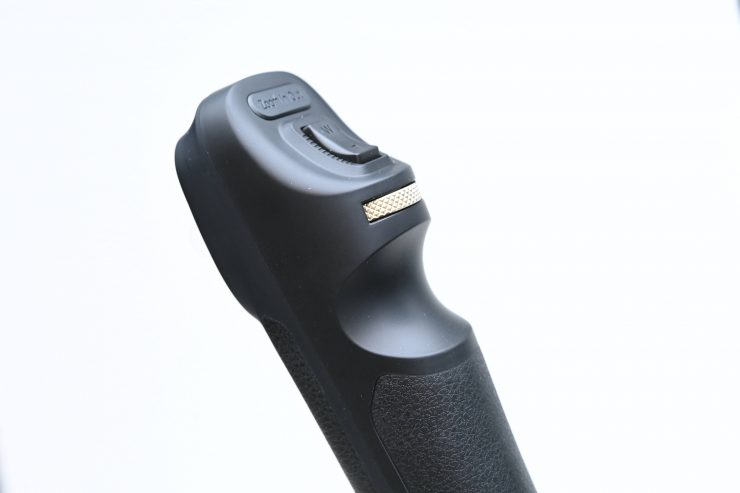
On the rear of the back handle, you will find a zoom rocker. This can be used to zoom compatible lenses or to control the optional focus/zoom motor. There is also a dial underneath the zoom rocker that is for making camera setting adjustments.
To the far right of where the camera baseplate goes, you will find the inputs for camera control, and on the opposite side, you will find the inputs for focus and zoom control.
On the tilt axis, you will find the camera control input, as well as the inputs for focus and zoom motors.
PhoneGo Mode
If you want to follow fast moving objects or people you can enter what is called the PhoneGo Mode. By single tapping on the Go button, the gimbal goes into its maximum follow speed. This is handy if you are filming sports or anything with fast moving motion. This is similar to Sports mode on the Ronin-S.
Motion Sensor Control
The gimbal has a built-in motion control sensor, so if you don’t want to use your smartphone on your gimbal, you can take it off and turn it into a motion sensor controller. By simply moving your phone, you are controlling the gimbal in real time. This is a nice feature and it’s impressive that it is a free built-in feature in the app. If you have used Mimic with a Freefly Movi or the controller mirror mode on the Ronin 2, it is a similar feature.
It does take a bit of time to get used to how it works, and it is not the most intuitive way to operate your gimbal, but once you get the hang of it it works fairly well. This feature can come in handy if you are using the gimbal on a jib or as a remote head.
Focus & Zoom Motors
Getting critical focus, especially when shooting 4K on a full frame sensor camera is hard at the best of times. In the last 12 months or so we have seen quite a few follow focus systems emerge for gimbals. The Crane 3S has a built-in focus controller on the gimbals handle, but they also have two optional follow focus (or zoom) motors that are available. On the Crane 3S you can connect up two follow focus motors, so you can use one for focus and the other for zoom.
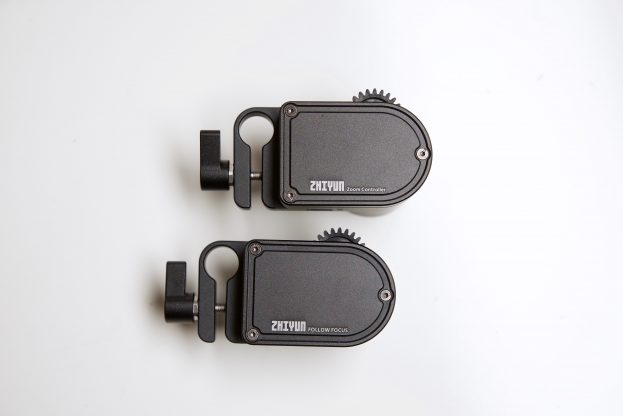
Now, there is actually two different versions of the motor available. One is the TransMount Lite Servo Focus Controller, and the other is the TransMount Max Servo Zoom/Focus Controller. While they look similar, the TransMount Max Servo Zoom/Focus Controller is slightly larger. Both Controllers will work on the Weebill Lab as well as the Crane 3 Lab and the new Crane 3S.
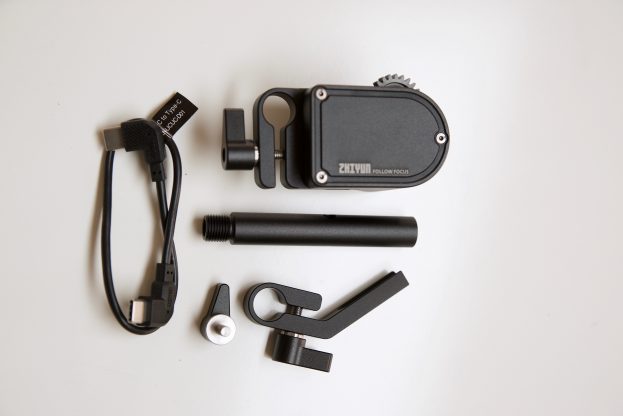
Included with Focus Controllers are the mounting bracket, a 15mm rod, and the power, control cable.
Both Focus controllers feature a tool-less design, and they attach to the gimbal using just the included thumbscrews. To attach, you secure it to the supplied support bracket and mounting rod using two thumbscrews, and attach this assembly to the bottom of the gimbal’s baseplate with the third thumbscrew. You then connect the servo to the gimbal with the provided USB cable and connect the camera to the gimbal with one of the camera control cables the gimbal comes with. The USB cable connection provides zero-latency signal transmission.
The external follow focus can be controlled in two ways, one is through a tactile wheel on its body, or through the app directly on your smartphone screen. If you use one as a zoom, you can also control it via the app or through a zoom rocker on the gimbal.
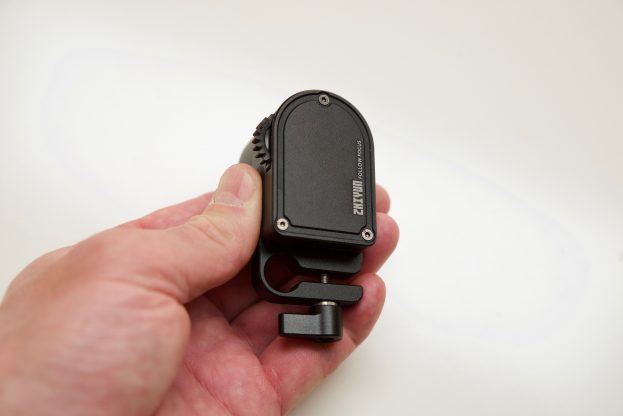
The external follow focus motors are relatively lightweight and certainly do work. You just hook it up to the gimbal with a cable and then you can control focus directly on the side of the gimbal. The motor is absolutely silent and doesn’t make any noise at all.
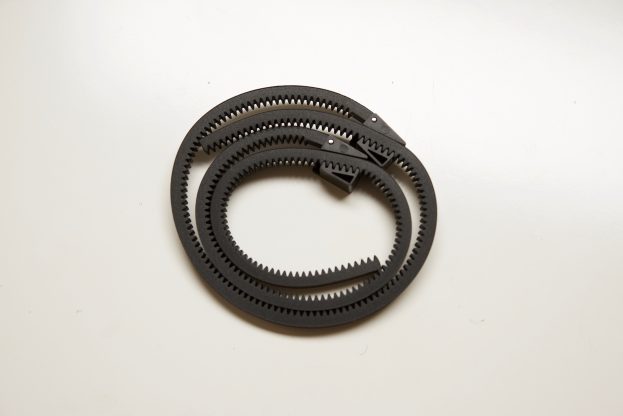
With the follow focus motor you get a couple of rubber lens gears that you can use on lenses that don’t have pitch gears. These work reasonably well, you just have to make sure you have then tight enough around the lens so they don’t slip or move. I found they were a little fiddly to put on to your lens and secure tightly.
While there is absolutely nothing wrong with how the motors operate or perform (with stills lenses) they do take a bit of time to install and set up. The whole process is a little fiddly and time consuming and by the time you add the rubber lens gear and attach another cable between the gimbal and the motor you end up with cables and bits and pieces everywhere. I think it would have made more sense to design a wireless system that communicated with both the gimbal and the app so you didn’t end up with so many cables. I would have also preferred to see the motors feature an inbuilt battery so they could be used without the gimbal.
How does it actually perform?
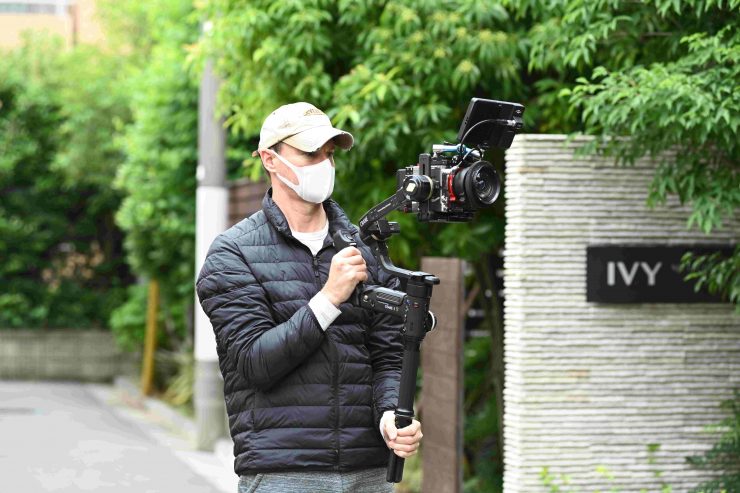
Features are great, but at the end of the day it’s still a gimbal, and therefore it needs to be able to create smooth shots. So how does the Crane 3S perform? The gimbals stabilization is, for the most part, nice and smooth, and with the increased motor strength it never really feels like its struggling even if you are running very heavy camera payloads.
While it works well, it is heavy. The package I was running, including the weight of the Crane3S, tipped the scales at 6.8kg (15lb). If you take away the weight of the gimbal, and the SmallHD monitor and arm I was still 2.2kg short of reaching the max. payload capacity. I wouldn’t want to be holding a gimbal package that was 2kg heavier than the one I was using!
I did find a problem that if you had the adjustment arm where the camera sits all the way out to its full extension the tilt motor would vibrate violently and make a lot of noise. This is obviously a design flaw.
I found that the majority of the footage I got was very smooth and usable, and the gimbal performed well. Like any gimbal or Steadicam, results will vary depending on how proficient you are as an operator.
Above you can see some quick example footage captured with the Crane 3S. This is not a collection of pretty shots, as all I was interested in is to see how the gimbal performed and how it was to operate and use, especially with a heavier camera package.
Above you can see some shots taken at a higher frame rate. To be honest his tells me nothing about a gimbals performance. Any gimbal shot looks good in slow motion.

As this gimbal can be used with a variety of cameras I also decided to do a couple of quick tests using a Nikon Z6. I wanted to see how the gimbal performs with a lighter camera.
Above you can see some vision from the Z6 and a Sigma 18-35mm F1.8 lens.
Like any new product there is always going to be a learning curve. It is very hard to make a comprehensive conclusion as to the performance of the gimbal without using it over a prolonged period of time.
One-handed gimbals always have the inherent problem of creating quite pronounced up and down movement when you are walking. This is due to the momentum of your body moving your arm up and down. With a two-handed gimbal, this is easier to control as you are essentially locking your shoulders to create a more stable platform. The Crane 3S actually does a fairly good job with this, although just like any one-handed gimbal, you will still get a slight up and down movement when walking.
The design of the Crane 3S does make it easier to get low angle shots and transition from a low angle to a normal level. Having two handles certainly does make a difference when doing these type of shots.
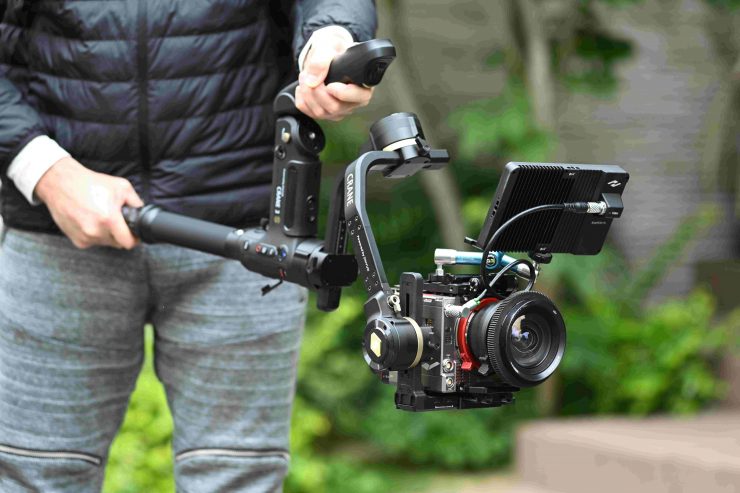
I also liked that because the gimbal is quite long you can actually use it to do dolly style shots.
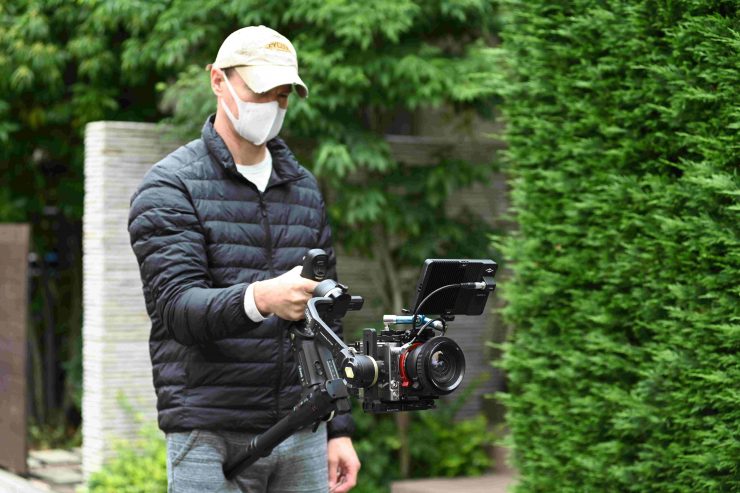
It is nice to use the two handles on the bottom of the gimbal because you can actually use it as a sort of brace against your leg when you are resting.
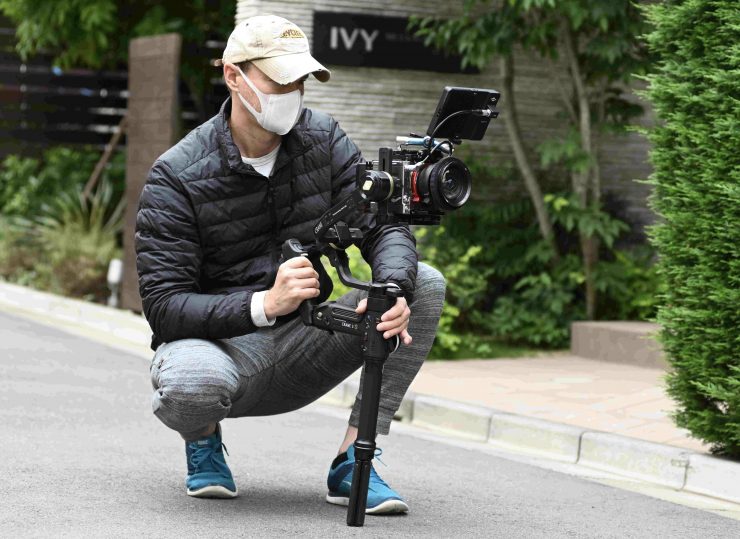
You can also use the two handles to place the gimbal on the ground to get a regular low angle tripod style shot.
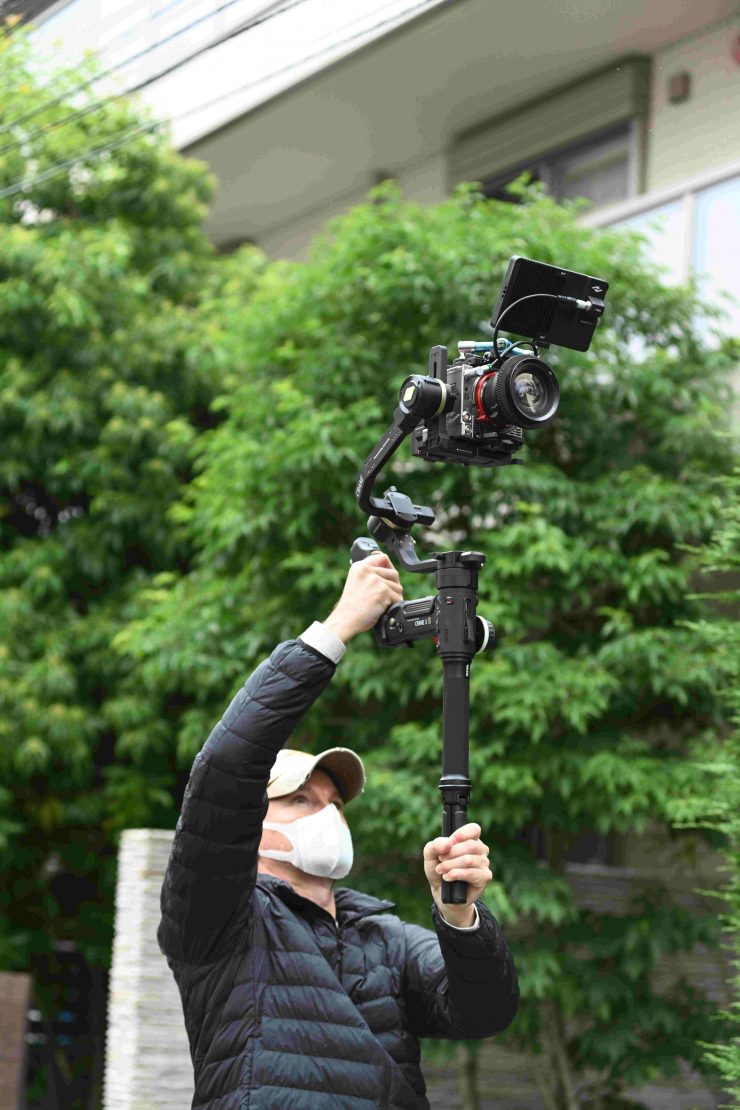
Another benefit of the two handles is you can elevate the gimbal quite high. This allows you to create some interesting perspectives.
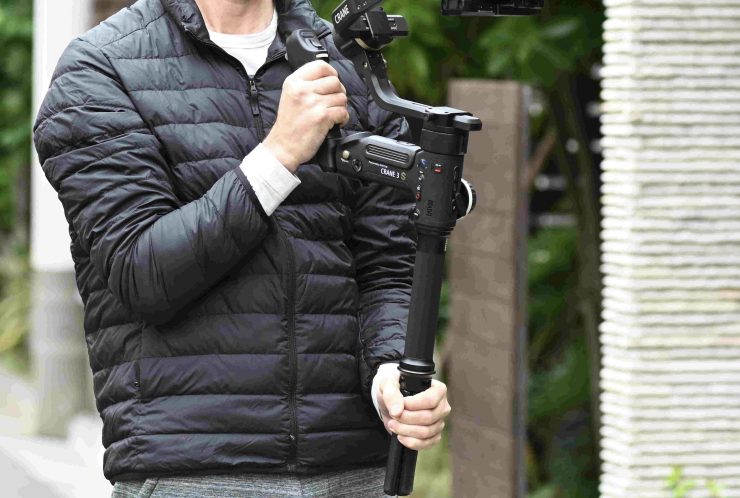
The problem I found when running a larger camera package and using both of the handles on the bottom of the gimbal is that to hold it comfortably you have to place your hand a long way down on the handles. When you do this you can no longer reach the joystick, so if you wanted to pan the gimbal left or right or up and down you can’t do it.
As far as the actual performance goes, I didn’t feel like it was that much different from any other Zhiyun product I had used.
The focus control wheel is located in a position where it isn’t that easy to use due to the way you have to hold onto the Crane 3S.
When you use your smartphone in the optional cradle I found it very hard to make changes without putting the gimbal down. To make changes you need to take your hand off the main handle, which means all of the weight gets transferred to the hand holding the rear handle.
To be perfectly frank, you are almost always going to be able to get better results from gimbals such as a Movi or Ronin. One handle gimbals have their limitations, but what you sacrifice in performance, you make up for in portability.
Accessories
- TransMount Lite Servo Focus Controller for Crane 3-Lab & WEEBILL LAB: $85 USD
- TransMount Max Servo Zoom/Focus Controller for Crane 3-Lab & WEEBILL LAB: $89 USD
- TransMount Quick Release Baseplate for WEEBILL LAB, Crane 3-Lab & Crane 2: $19 USD
- TransMount Camera Backing Base for WEEBILL LAB, Crane 3-Lab & Crane 2: $19 USD
- TransMount Focus & Zoom Servo Combo Kit for Crane 3-Lab: $74 USD
- TransMount Phone Holder with Crown Gear for Crane 3-Lab & WEEBILL LAB: $49 USD
Competition
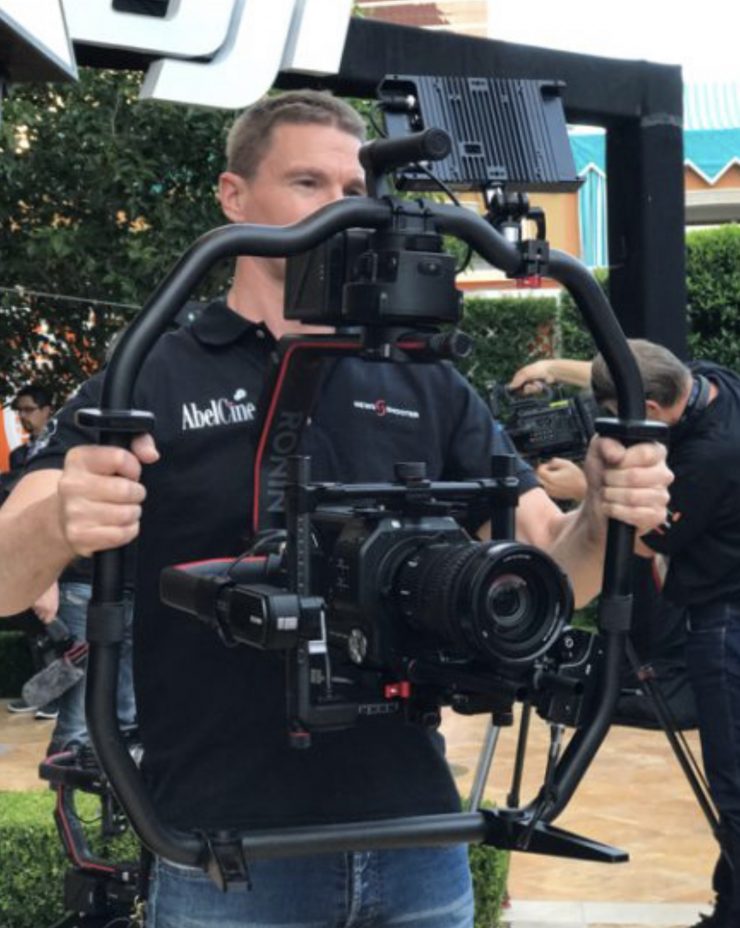
This is an interesting one, because if you want to run camera and lens payloads that are over 5kg, there aren’t many options unless you want to go to larger gimbal such as a DJI Ronin 2 or Movi Pro.
Realistically, if you want to stick to a smaller, more compact gimbal solution that is easier to travel with, the Crane 3S is arguably the only solution.
Price
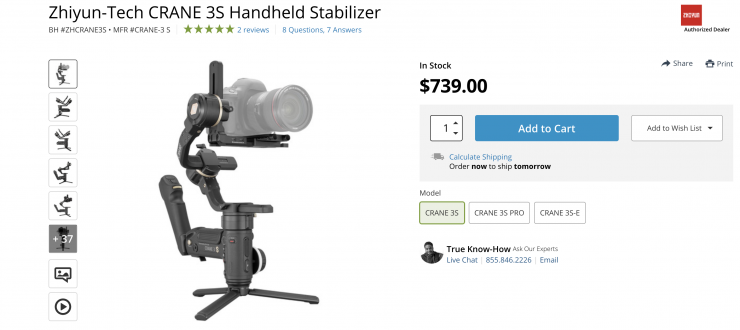
The Crane 3S comes in a range of different configurations.:
- Zhiyun-Tech CRANE 3S Handheld Stabilizer $739 USD
- Zhiyun-Tech CRANE 3S PRO Handheld Stabilizer $1,149 USD
- Zhiyun-Tech CRANE 3S-E Handheld Stabilizer $649 USD
The Crane 3S is more expensive than most other single-handed gimbals, but it does have a much higher payload capacity.
For the price, it represents very good value for money. As a comparison, a DJI Ronin 2 retails for $8,399 USD. Yes, it has a payload capacity of 30 lb, but before the Crane3S came along you would have had to use something like the Ronin 2 to run a rigged up Sony FS7.
Conclusion
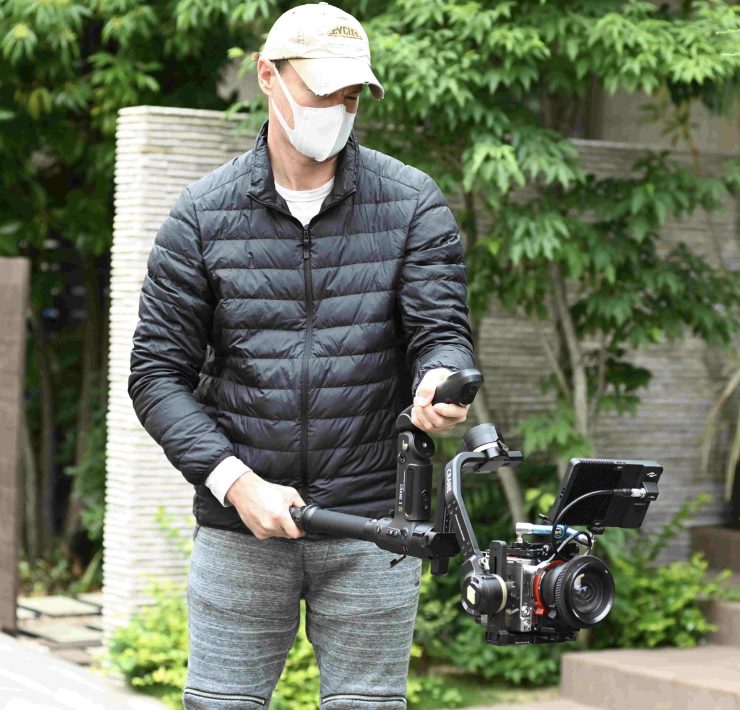
Zhiyun has certainly made a product that will suit some shooters, especially if you have been wanting to run a mid-sized digital cinema camera but didn’t want to spend a ton of cash.
Does it get heavy? Yes. Do you have to put it down after a few minutes? Yes. If you want smaller sized gimbal that can run heavy payloads the trade-off is going to be the time you can spend using it before fatigue sets in. This is something you clearly need to understand if you are going to use it.
Unless you want to use it with an Easyrig or something similar you may find yourself saying more expletives than normal.
This is not a gimbal for everyone and you really need to think long and hard whether it is what you actually need.
I personally don’t like heavy one-handed style gimbals, but that’s just me. If you can’t hold a one-handed gimbal for more than a few minutes without having to put it down then that is a problem. I am less likely to use a gimbal that I can’t hold for more than a couple of minutes than one I can hold comfortably for a lot longer.
I have to give credit to Zhiyun. They are constantly improving their products and they have been at the forefront of innovation and features when it comes to single-handed gimbals.
I’m not a big fan of using heavy gimbals if you are just running smaller DSLR or mirrorless cameras. In that regard, for me at least, I prefer the smaller Weebill Lab or the Crane Lab 3 over the Crane 3S. In saying that, using a larger gimbal puts less stress on the motors and does give you more flexibility to use larger lenses and bigger cameras, but that does come at the expense of usability.
Zhiyun has certainly thrown everything but the kitchen sink into the Crane 3S, and there is no denying that it is a very feature-rich gimbal. Despite all of the features and pizazz, it’s nice that you don’t need to use any of them if you don’t want to. Zhiyun has managed to still make a gimbal that can be used for both simple and more complicated shots and is versatile to handle a large range of camera and lens packages.
The gimbal itself performs pretty well, but it’s not perfect.
The new latches are a really nice touch, but to be honest, I think they are there out of necessity more than anything else.
The optional electronic follow focus and zoom motors work well, but in all honesty, I’m not sure how many people are actually going to use this. As it only works on a gimbal, it’s not a very flexible product. Don’t get me wrong, it’s great to have, but for me personally, when I use a small gimbal it’s usually with a wide-angle lens where you don’t tend to adjust the focus and zoom that often.
The wireless video and app that allows you to monitor the images from certain cameras and make changes have all been improved by Zhiyun, to the point where it is much more reliable and easier to use. The image quality of the wireless signal is a lot better than it was with the Weebill Lab, but it still has some latency issues every now and then.
In summing up I think Zhiyun has made a reasonably good gimbal that certainly offers pretty decent value for money, although it is a fairly niche product that is not going to appeal to everyone. Its performance as a gimbal is pretty good and the fact that you get so many included features is bound to make it a popular choice for shooters looking for a compact, easy to travel with gimbal that can handle larger camera packages.
The biggest caveat is the weight. Carrying around a gimbal and a payload that weighs upwards of 8Kg is a back, shoulder, and arm breaker.
If you are planning on buying the Crane3S you better hit the gym!
Like what we do and want to support Newsshooter? Consider becoming a Patreon supporter and help us to continue being the best source of news and reviews for professional tools for the independent filmmaker.

